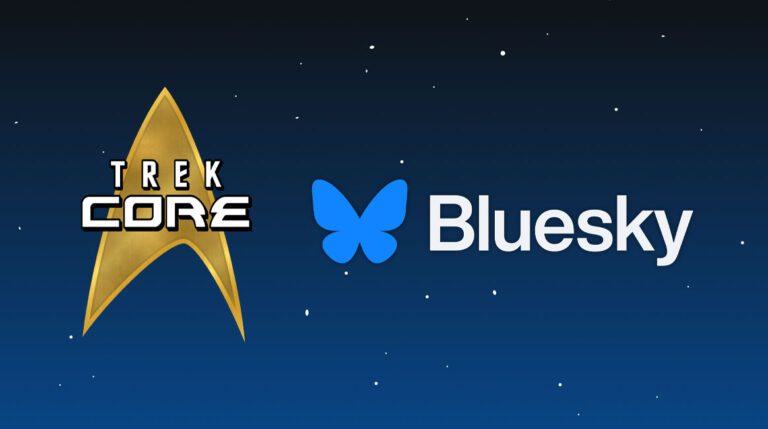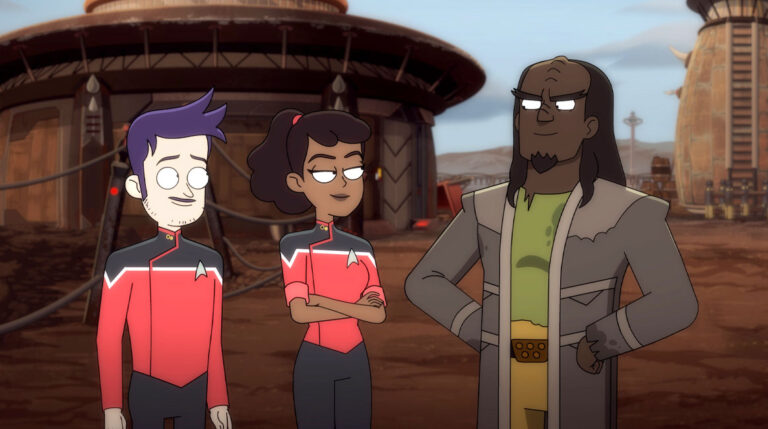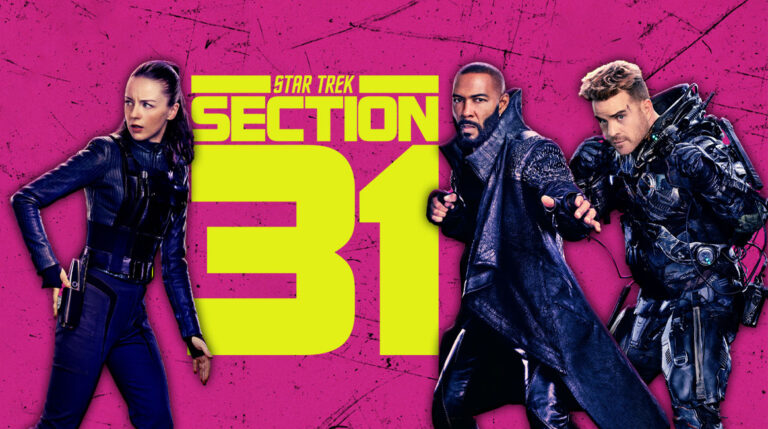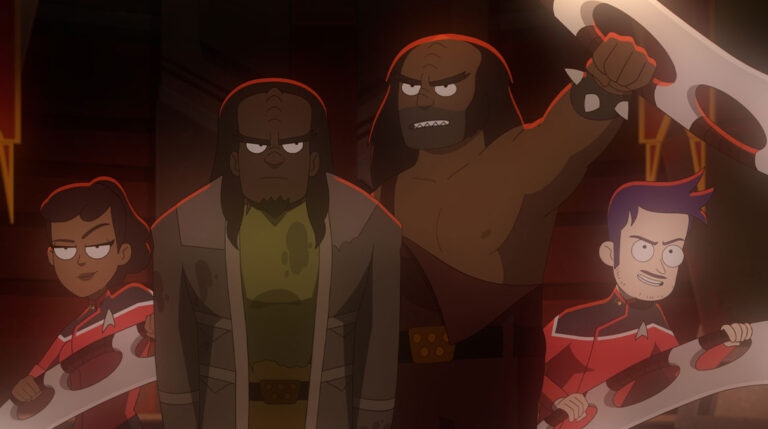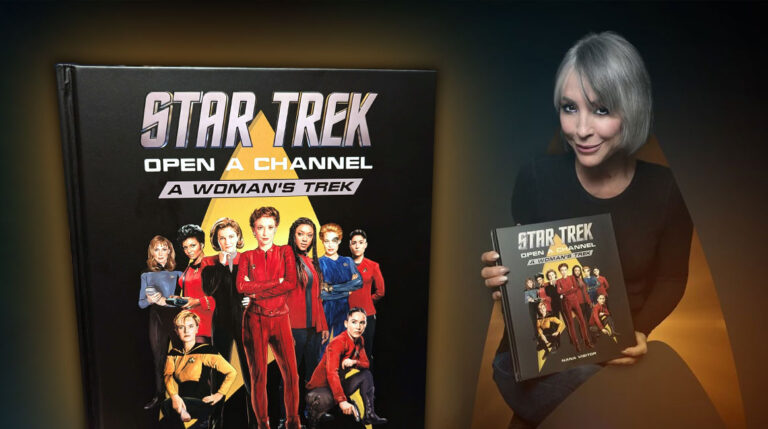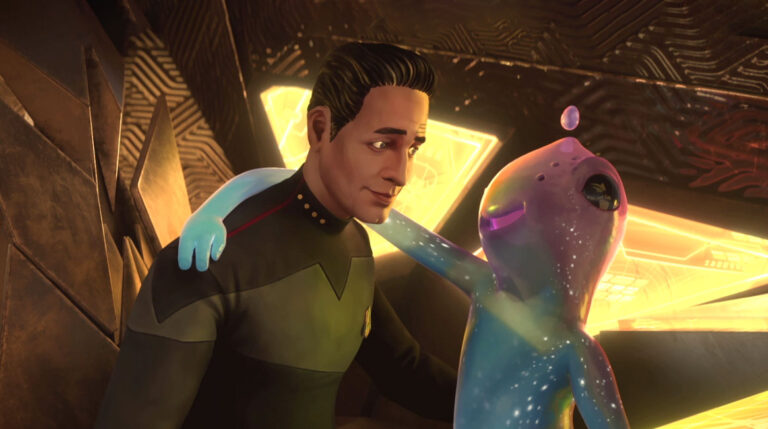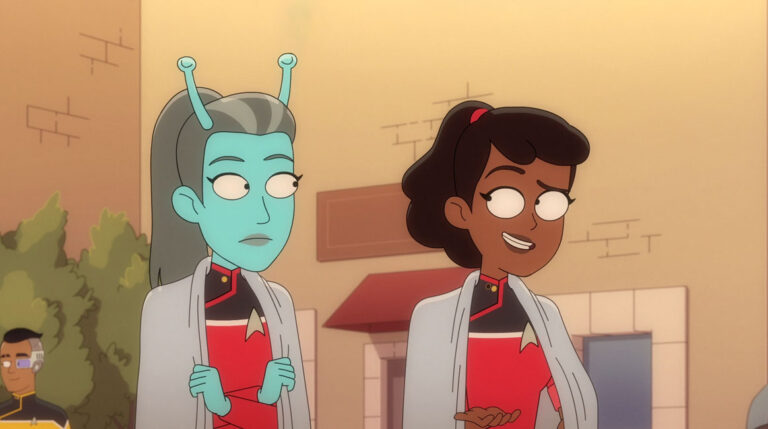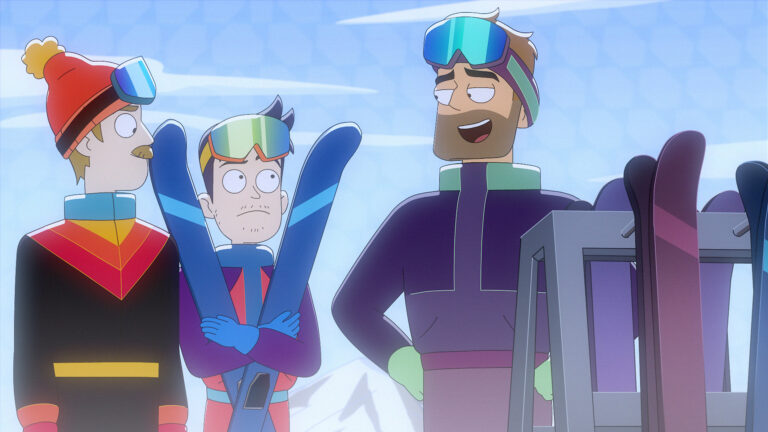Social media platforms all have their rise and fall in popularity — and you’ve surely followed us on several of them over the years. This week, TrekCore’s social media presence is making a move to Bluesky, and we hope you’ll join us there.
We’ll continue to post site headlines (and share critical information when necessary) on our Facebook and X (Twitter) accounts as we publish new stories, but for day-to-day interaction Bluesky is our new primary home for social media engagement and interaction.
You can find us — and a growing number of other Star Trek fans — at https://bsky.app/profile/trekcore.com once you create a free user account.
![]()
STAR TREK: LOWER DECKS Review — “A Farewell to Farms”
Star Trek: Lower Decks makes another enjoyable detour away from the Cerritos this week in another “larger world” story in “A Farewell to Farms.” It’s a conceit that the show first pioneered with the universally-acclaimed “wej Duj,” followed by the not-so-popular “A Mathematically Perfect Redemption” that centered on Peanut Hamper.
Lower Decks has enjoyed throwing us the occasional episode that explores what it means to be Lower Decks that center the stories of characters who are not our usual core foursome, and this episode is a worthy entry.
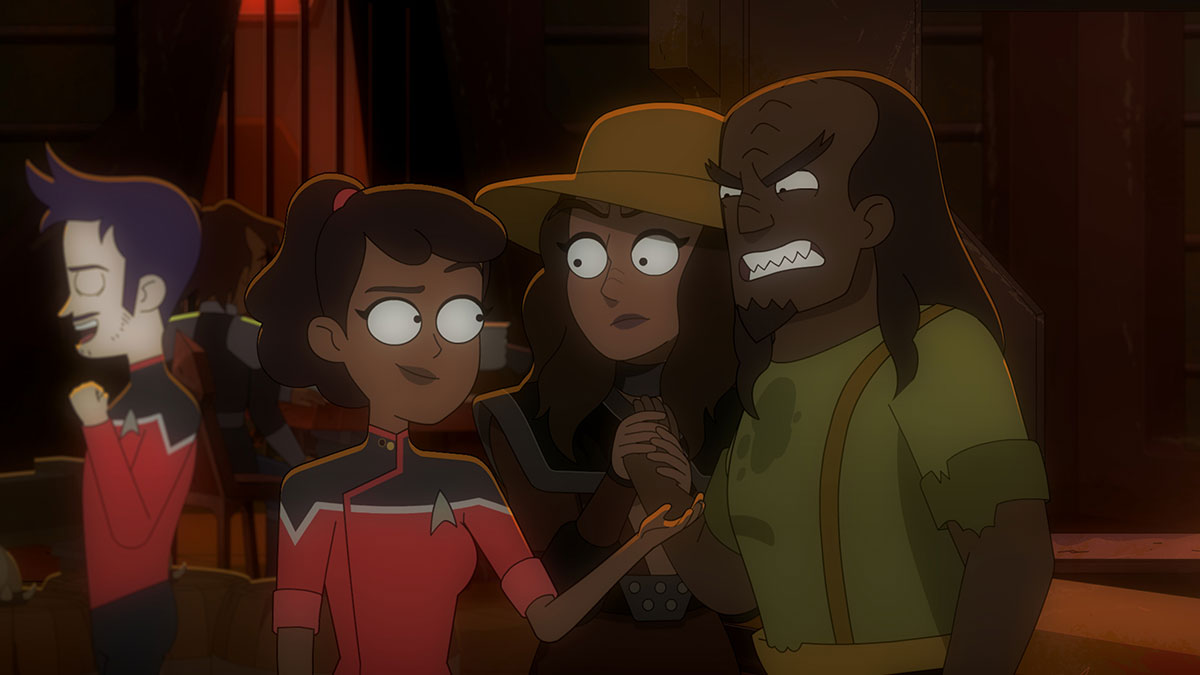
This time, “A Farewell to Farms” takes us to Qo’noS to revisit Ma’ah (Jon Curry), the Klingon lower decker turned captain — turned Lower Decker again — who was first introduced in “wej Duj” and had a critically important role helping Mariner address her issues in last season’s “The Inner Fight,” and “Old Friends, New Planets.” Returned to Qo’noS in disgrace after his crew had mutinied against him, Ma’ah works to find his new place in the universe – with a little help this time from Mariner and Boimler.
One of the key themes of Lower Decks has been the journey that everybody goes on — usually in youth (but not always!), and usually in the formative parts of your career (but not always!) to find yourself and your place in the universe. Throughout the whole series, our characters have navigated the expectations that others have for them, or that they have for themselves, to get comfortable with who they are and find their authentic place in life.
We’re seeing that play out for Boimler this season as he clearly tries to inauthentically ape his alternate universe doppelganger. Tendi’s been through it with her visit to Orion. Mariner blew up a Genesis Device as part of her arc at the end of last season.
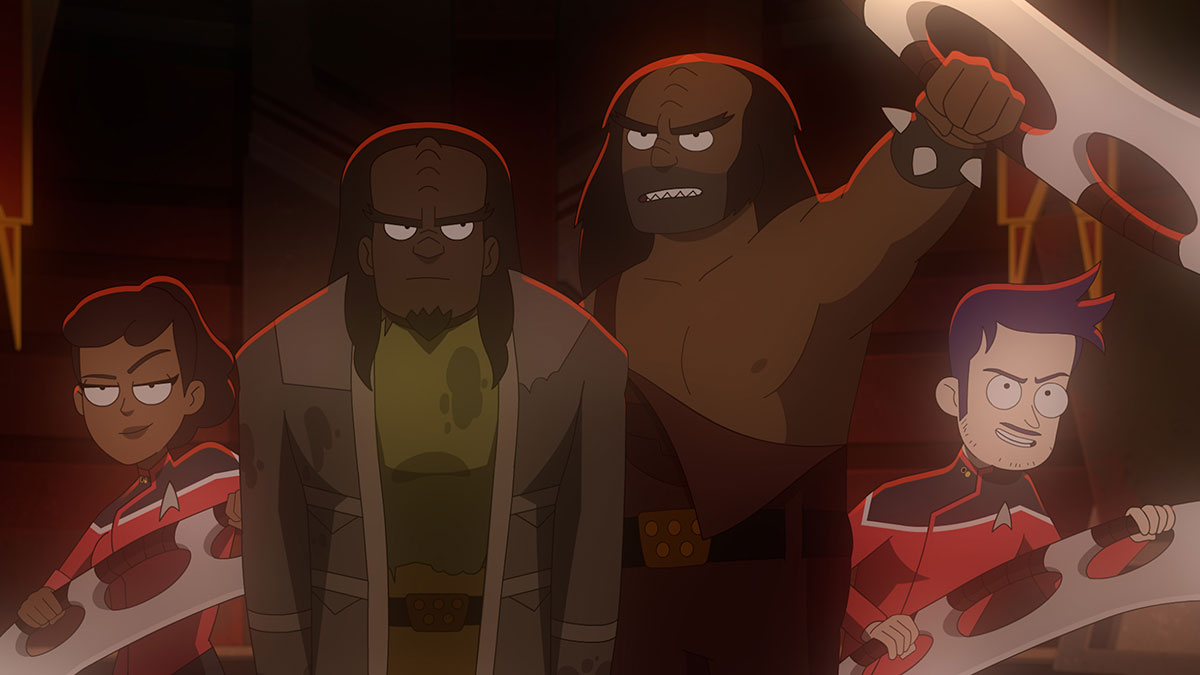
And now Lower Decks turns to Ma’ah, the compelling and endearing Klingon who uses his experiences in this episode to choose his own path. In some ways, Ma’ah’s journey is similar to Worf’s in that they are both Klingon characters who decide to eschew the “usual” way of being a Klingon to inhabit a more authentic version of Klingoness that reflects the individual character’s uniqueness. But given Ma’ah is a Klingon living on Qo’noS and a product of the Klingon system, it’s a compelling and different perspective that sees Ma’ah decide to hold true to his principles rather than submit to the Klingon system of advancement.
Mariner (Tawny Newsome) and Boimler (Jack Quaid) play secondary roles in this story, but their role is a welcome one, particularly as Boimler appears to be on a thematically similar journey to Ma’ah, but hasn’t yet realized what being authentically him looks like yet. And it’s always fun to visit the Klingon homeworld, and especially to see a part of the Klingon homeworld outside of the capital city or other major urban areas for the first time.
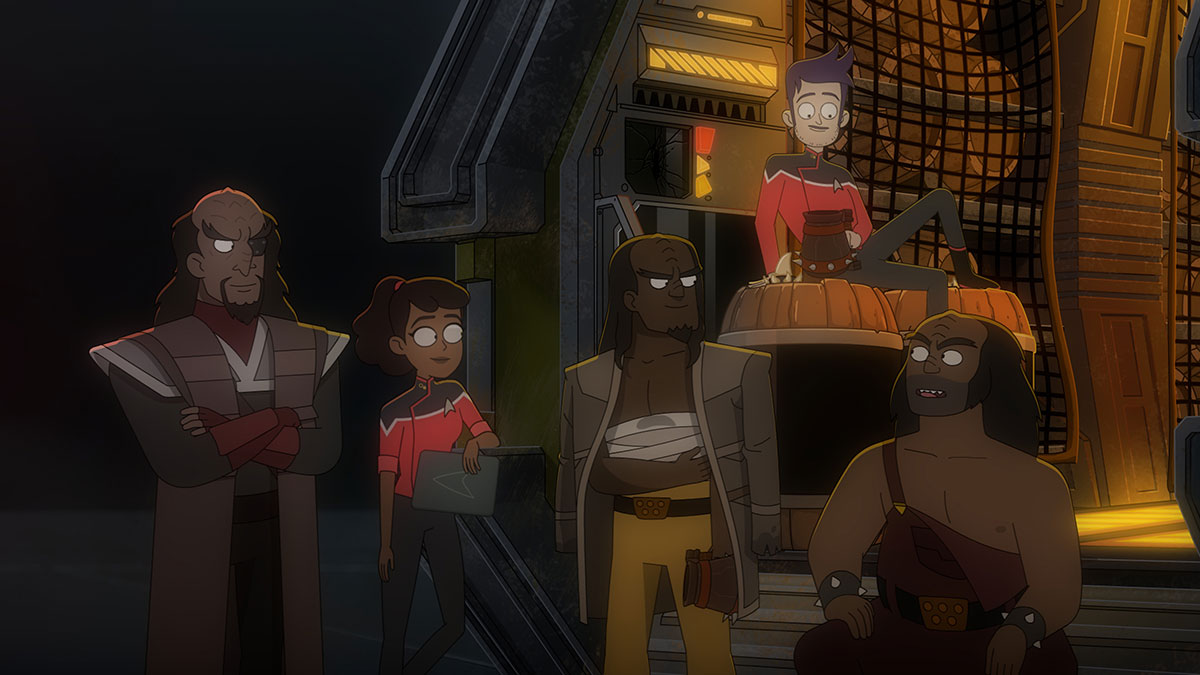
Outside of the awkward scenes in “Birthright,” I don’t think we’ve ever seen a Klingon farmer before, and so it’s great to see another take on Klingon life that authentically integrates the concepts or honor and combat that are endemic to all Klingon life, but in a more real world that acknowledges it needs farmers and bartenders and other roles in order for a society to function.
The Cerritos storyline meanwhile is all comedy, with a deeper look at Dr. Migleemo’s (Paul F. Tomkins) species, who we now know are called the Cloacans. Having a birdlike race centered around hedonism related to food whose most revered icons are food critics is a funny premise, and there’s a lot of good food-based jokes in this one. But it’s ultimately just a humorous throwaway, the real meat of the episode is on Qo’noS.
TREK TROPE TRIBUTES
- I am always here for an episode structured around an arcane Klingon ritual that revolves around the endurance of a lot of pain, like TNG’s “The Icarus Factor,” DS9’s “You Are Cordially Invited…” or VOY’s “Prophecy.”
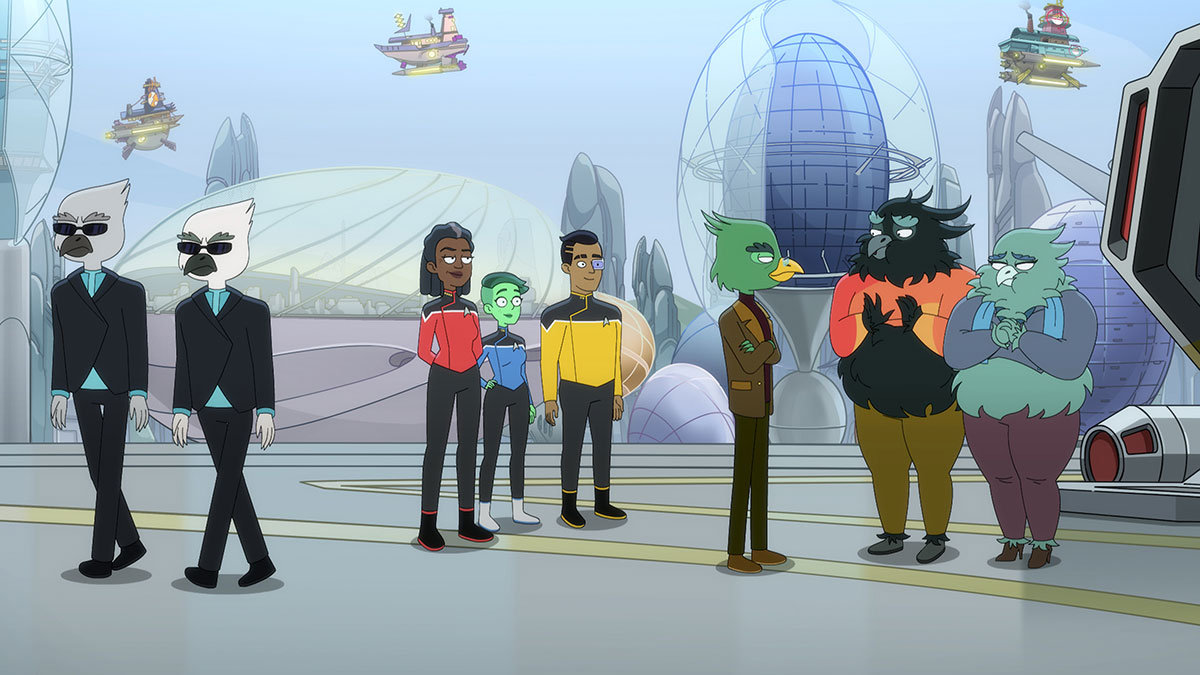
CANON CONNECTIONS
- The Klingon architecture of Ma’ah’s family farm matches the architecture seen on Qo’noS in the 22nd century when Captain Archer visited the planet in “Broken Bow.”
- Ma’ah uses a flip communicator similar to the ones seen used by the Klingons in the Original Series.
- General K’orin (Jess Harnell) reprises his role from Season 1’s “Envoys.”
- The painstiks used in the Rite of Unending Pain are the same model of painstiks used to shepherd Worf into adulthood in “The Icarus Factor.”
OBSERVATION LOUNGE
- I love when the show swaps out the usual opening credits sequence for something a little more cinematic. It makes the episode feel special, and this one was very well done!
- “Experience biJ!” “You experience biJ!” is a loving references to the Star Trek: The Next Generation — A Klingon Challenge interactive VCR board game, when the devious Klingon character who had hijacked the Enterprise would force you to miss a turn rolling the dice.
- While you see that on Ma’ah’s family farm they produce bloodwine, it still isn’t clear (and is a long running thing in Star Trek) what bloodwine is actually made from. The fact that the family raises targs would imply that bloodwine, if it is indeed blood, is made with targ’s blood, but you also see Ma’ah stomping on gagh in a similar way to traditional winemakers stomp on grapes to make human wine so…pick your poison!
- Sir Legnog and Madam Gonald continue Lower Decks’ unbeaten record of hilarious Star Trek alien names.
- Banished from the Great Seating Chart, the Traditional Amuse Bouche, Flavor Prison, the Lower Decks writers were clearly having a blast with all the food jokes this week.
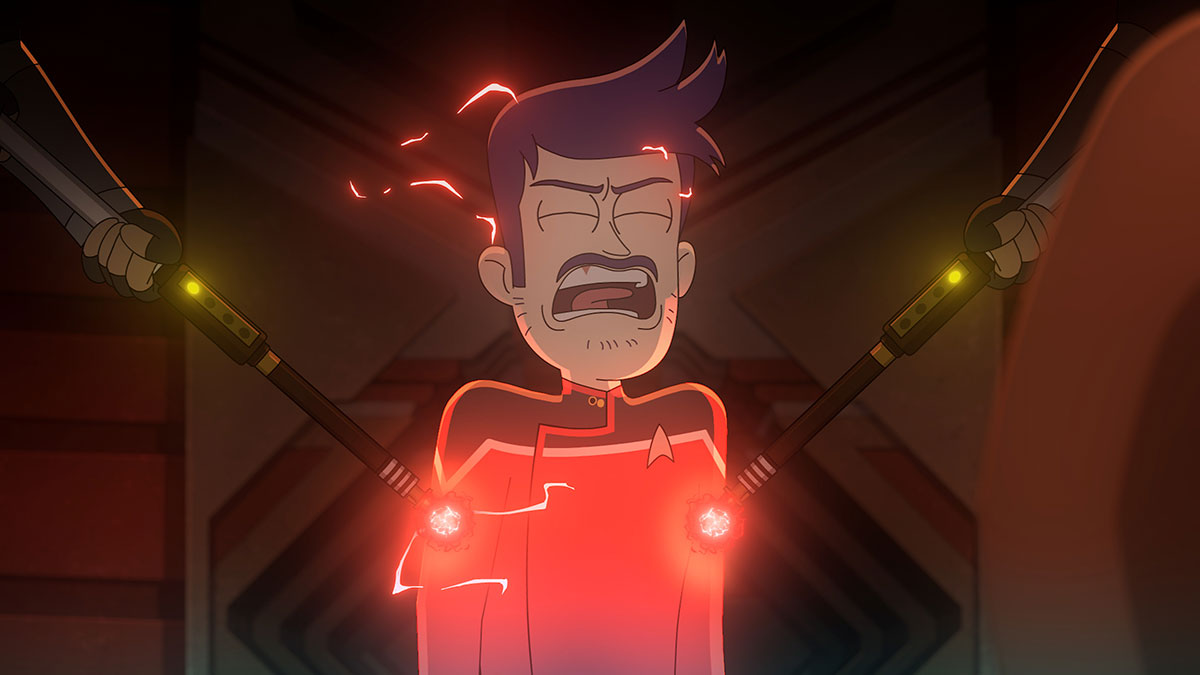
“A Farewell to Farms” combines a Klingon as hell A-plot (that hews to the series’ central premise) with a Migleemo-flavored B-plot that’s all jokes into an enjoyable episode of Lower Decks that gives us a little more time with our beloved Ma’ah before the season wraps up.
With the knowledge that the interdimensional rifts that have been an underlying subplot of the whole season are being made and not naturally forming, it looks like the season’s metanarrative is beginning to come into focus. I can’t wait to see where it takes us next!
![]()
Star Trek: Lower Decks Season 5 continues next week with “Starbase 80?!” premiering November 14 on Paramount+.
NYCC Interview — Setting the Stage for STAR TREK: SECTION 31 with Cast and Director Olatunde Osunsanmi
We’re wrapping up our coverage of this year’s New York Comic Con event today with our interview with several members of the Star Trek: Section 31 cast, ahead of the streaming movie’s January 24 debut.
TrekCore joined director Olatunde Osunsanmi, actors Kacey Rohl, Omari Hardwick, and Rob Kazinsky in a discussion with several other outlets to talk about the themes of the Michelle Yeoh-led production, bringing darker elements into the optimistic Star Trek future, and more.
This interview has been edited for length and clarity.
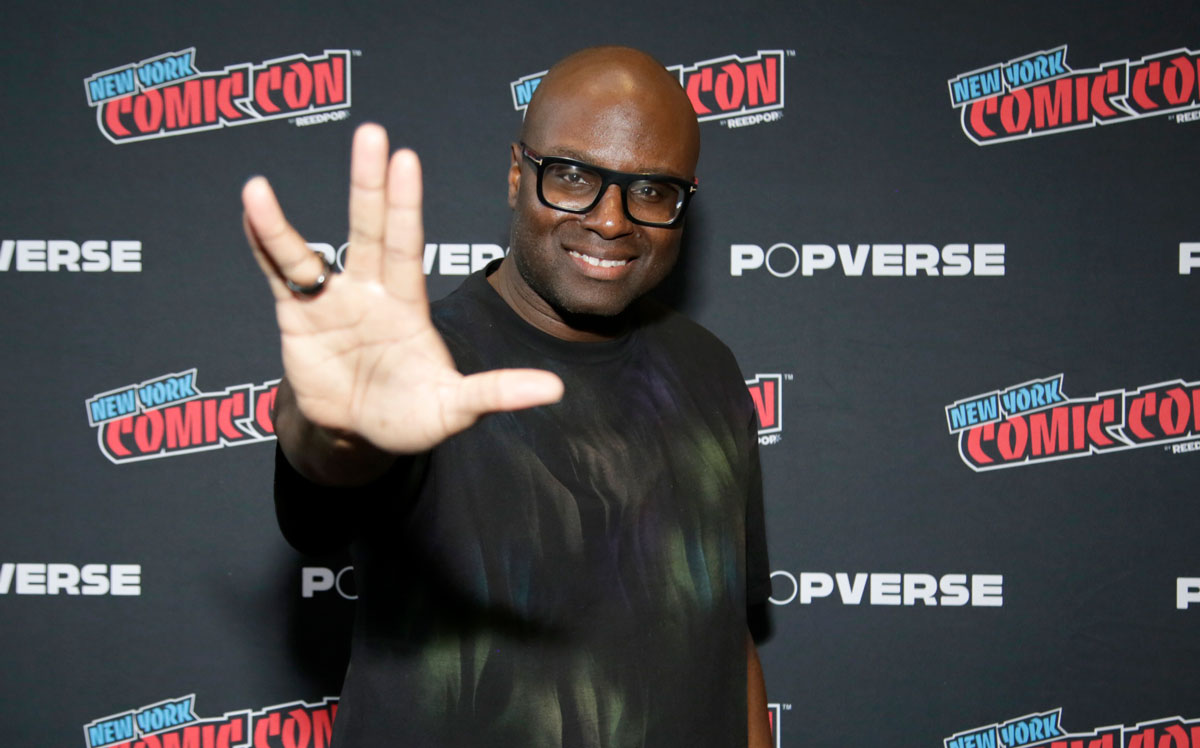
Q: For those who haven’t been following the project, how would you describe Star Trek: Section 31?
OLATUNDE OSUNSANMI (Director): Section 31 is an action-adventure Star Trek movie that follows a group who is like the CIA of Starfleet — and follows a bunch of operatives at the edge of the galaxy, outside of Federation space, where Starfleet’s not supposed to go. They’re joined by Michelle Yeoh, reprising her character Philippa Georgiou from Star Trek: Discovery, and they get up to a bunch of shenanigans.
It’s wild, it’s fun, it’s a joy, and it’s inspirational.
Q: Will there still be any of the traditional Star Trek ‘morality play’ storytelling in the movie?
OSUNSANMI: This is what I love about science fiction and fantasy-adventure, it’s allegorical. We get to talk about things that are usually very difficult to talk about in real life — we get to talk about them in very exciting ways, and very graphic ways. For me, one of the major themes of Section 31 is: everyone has to atone for what they’ve done in the past, and along with that, everyone is capable of change. Everyone is capable of transforming themselves and being better, if they dedicate the time to doing so.
I think that really resonates right now, and it’s a really important message to tell. There’s also the Star Trek thing, too, which is just aspiring to be good, to be better. This movie does tell that story.
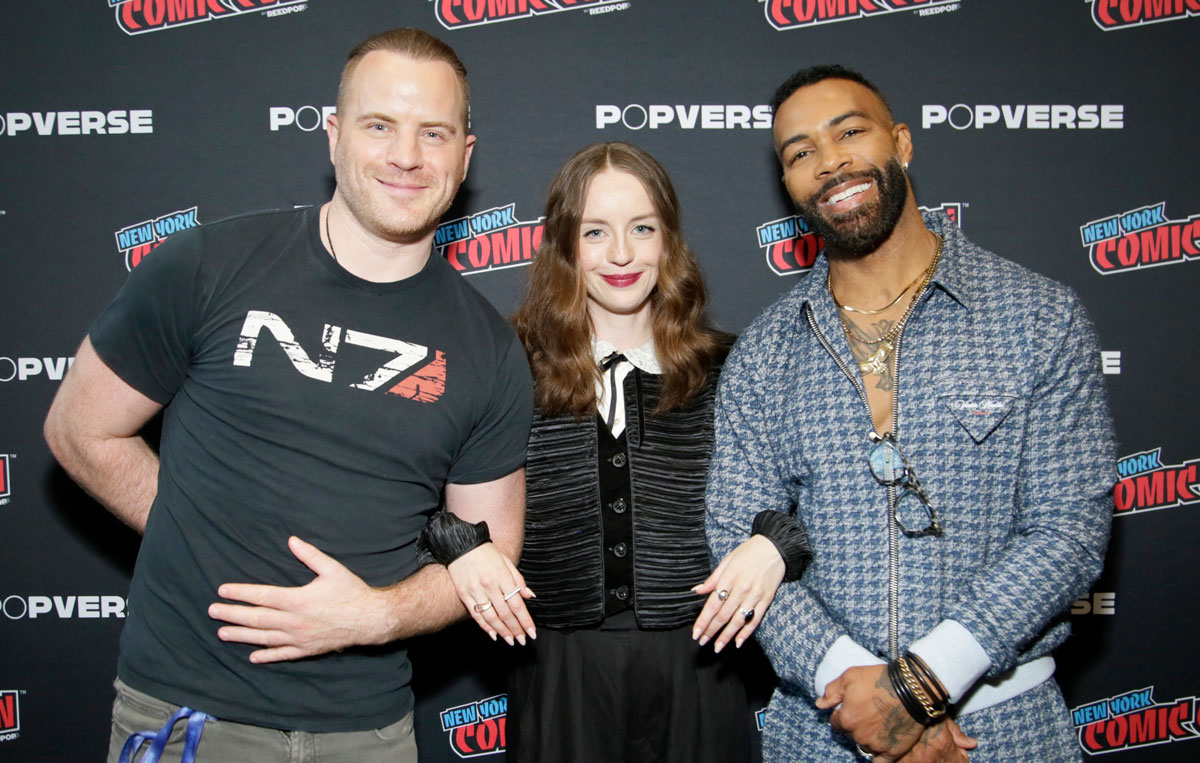
Q: Could you tell us about your characters — and if you looked to any other Star Trek characters for inspiration your roles?
OMARI HARDWICK (Alok Sahar): I’m going to let Rob go first, he was our Star Trek connoisseur.
ROB KAZINSKY (Zeph): Yeah, that’s me, I was the annoying guy! [laughs] Well, Section 31 is set in the Lost Era, right? It’s set before The Next Generation, before so many characters came into the franchise — but I would say every one of our characters has a little bit of Q in them. They’re all mischievous, they’re all there to be anarchists, they’re all outside the Federation system… all just slightly to the left, not following the rules.
There’s that anarchic type of element to them, but they’re all very unique. It’s such a deviation from what traditional Trek is, an irreverent and inherently non-Trek style that we’re bringing in, and in a few years there may be future Trek actors who refer to what Michelle Yeoh and Omari do with their characters. I don’t think you’ve seen anything like this in Trek before.
HARDWICK: My character is maybe a bit more frayed, but Alok is very much like his name — he’s the most locked amongst the motley crew of thieves. And when I say “thieves,” I mean that in the sense that we are stealing some of the rigmarole, the standard of what “had to be done.” We break all those rules and barriers, but Alok is the bridge that still has to be crossed to get to the places we’re trying to go.
And I don’t think that I find it that different than what “old” Star Trek was trying to do. To Rob’s point, it’s the manner in which we’re getting there — that’s the part that’s different. And Alok really does maintain himself as that bridge – you have to walk a bit more standard across him, but the others get to do whatever they want to do, which means they have a bit more fun. [laughs]
It’s a little annoying, but I start to rake myself across the coals a bit — and with Zeph, I’m able to help put out some fires in a very fun way, which afforded us some time for improvisation.
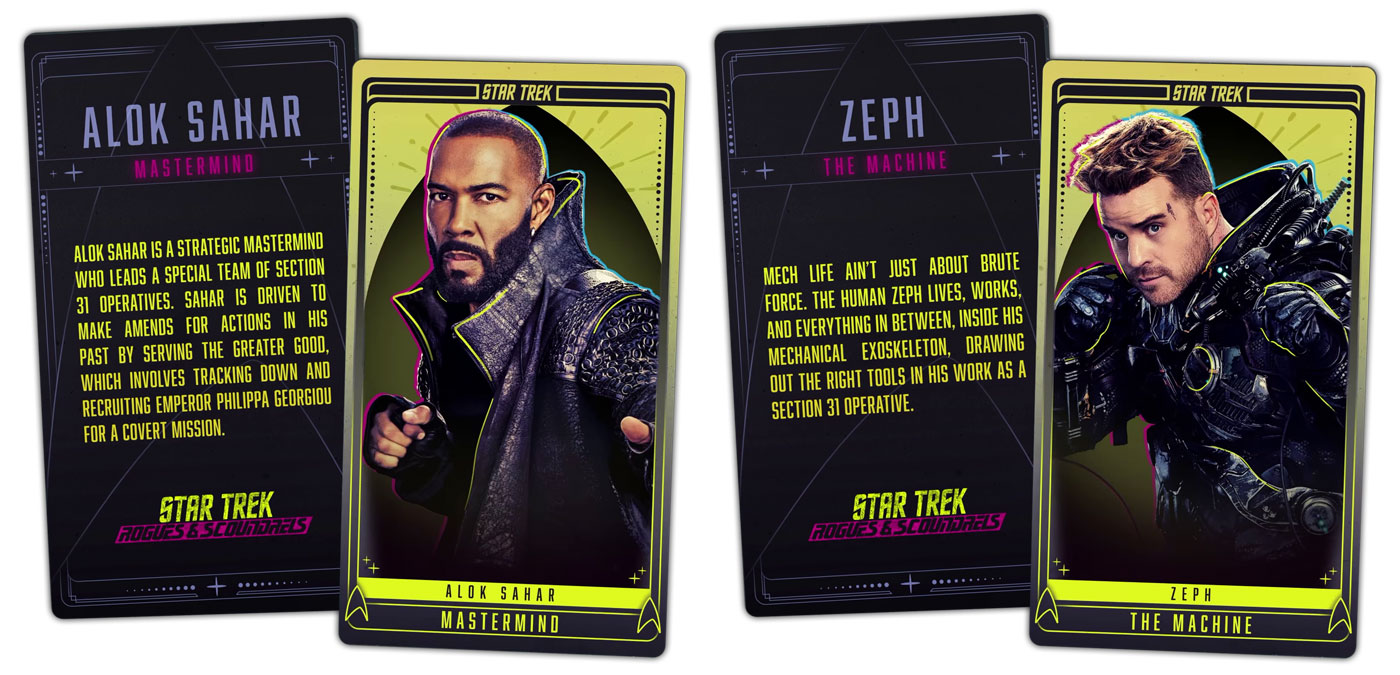
KAZINSKY: They always had three cameras running at all times; something you never really had with Trek before. We were improvising all the time, sometimes whole scenes. I think we added like 18 pages of dialogue that they had to cut through in editing. We were having too much fun!
HARDWICK: And because he’s the biggest Trekkie in the cast, we still had those conversations about making the movie for the fandom — because the fanbase is the biggest part of this whole thing. So we’d improv, and that helped us get loose and understand our characters a bit more, but at the end of it all you still have to stay within the confines of what fans may want to watch — because this movie is really different from what’s been seen prior.
Q: Kacey, what was your approach to taking on the one character already established, Rachel Garrett from “Yesterday’s Enterprise”?
KACEY ROHL (Rachel Garrett): I watched that episode a bunch, and thought Tricia O’Neil did such a beautiful job with it. At one point, I attempted — really, copying what she did — and that didn’t feel like it was right. There wasn’t enough flow to it for our process. But I watched the episode many times, even when we were shooting, and trusted that would enter into what I call ‘the soup’ of Rachel Garrett, along with a lot of guidance from Olatunde.
OSUNSANMI: Kacey brought a lot of gifts; I think fans are really going to love her as Rachel Garrett.
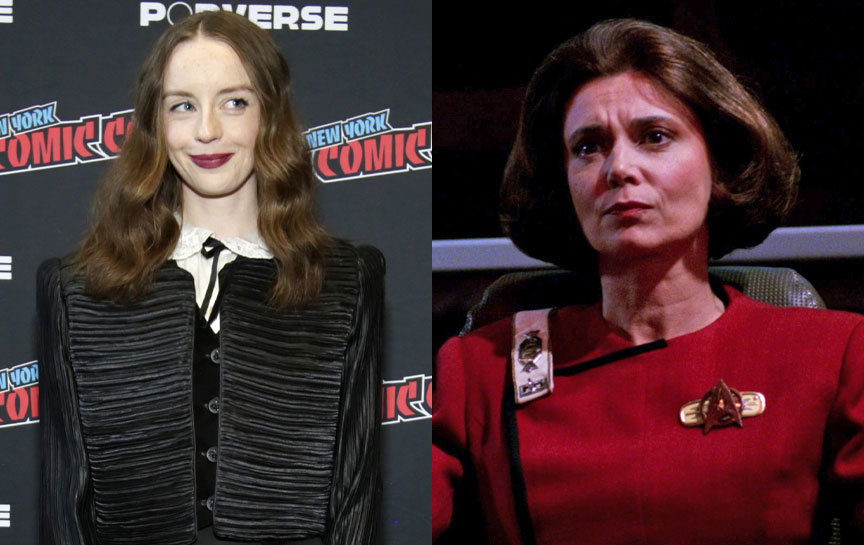
Q: How difficult was it to balance the darker themes of Section 31 with the generally optimistic setting of the Star Trek future?
OSUNSANMI: Well, I think it’s intimidating, because you’re trying not to touch the third rail — I grew up when Next Gen and DS9 were airing, and they were so wonderful — but we didn’t want to make a movie where people would feel sad at the end. We want you to be uplifted about life, the way I felt watching Trek growing up.
It was interesting to thread the needle on that — there’s a lot of drama in the movie, for sure, but there’s a lot of fun and action and joy. So on a difficulty scale of one to ten — with a ten being, like, redoing the first Trek pilot – I’d say Section 31 was about an eight.
KAZINSKY: This question is kind of at the core of what Section 31 is about, because a lot of Star Trek fans – including myself! – hate the fact that Section 31, the organization, exists. Because we’ve all bought into the optimistic future that Roddenberry designed, and the idea that this kind of group wouldn’t be needed anymore.
But the truth is that Sisko quote: “It’s easy to be a saint in paradise.” For me, that’s been the motto and creed of this whole production – because of what we in Section 31 do, you’re able to have that Federation. Should Section 31 exist in the first place… I think that’s just an enlargement of the universe.
We’ve all been shown the Roddenberry-esque future. But if you’re going to have this, realistically, it would always have something like Section 31 – and the dirty work of people like us allows the rest of Starfleet to be so sophisticated.
HARDWICK: To me, what I loved about Roddenberry’s idea for the future is that it was about morality. When we draw that line in the sand, what side of that line do you want to be on? Whatever you believe in, there are always people who are good, and people who are bad – and sometimes good people can do bad things, and those bad people can do some good.
So I adore Section 31 – because you need some crew to say, “No way, that shit ain’t right!” And maybe they do it in a way that’s pretty rogue, but I appreciate the flexibility in how they do it.
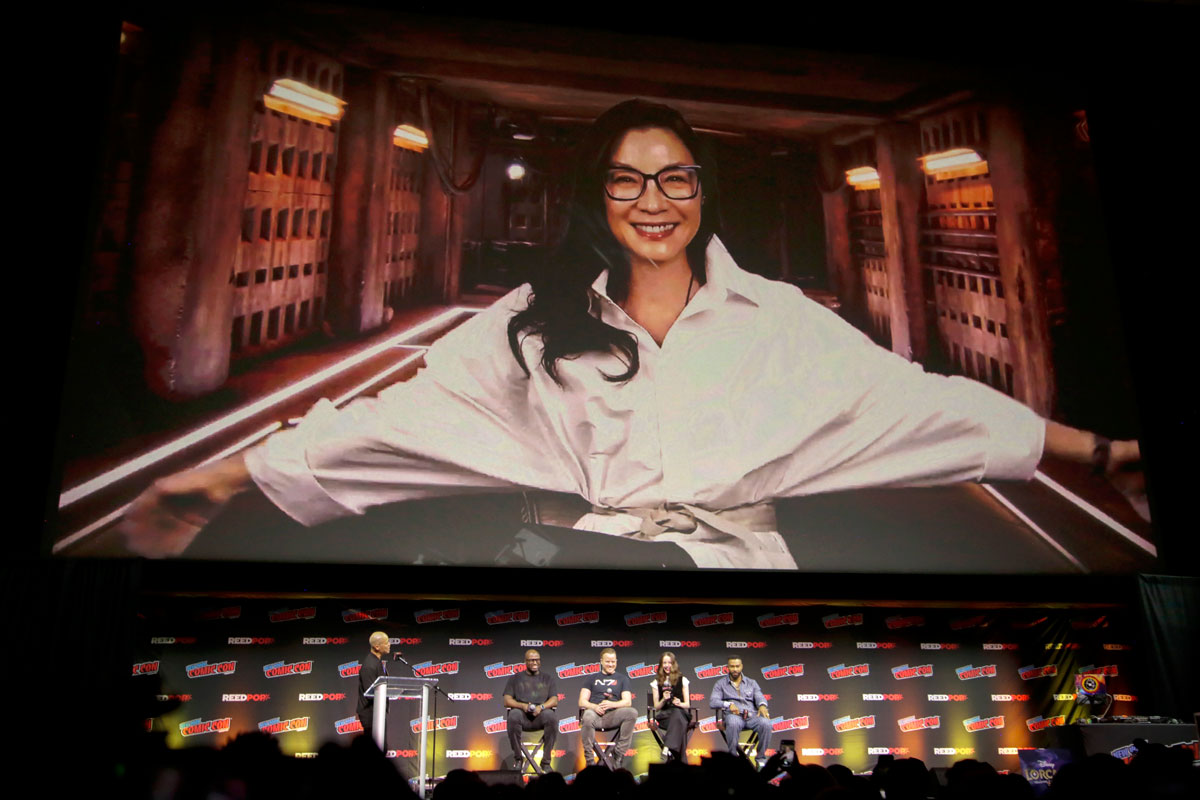
Q: When you have a character like Georgiou — sometimes a villain, sometimes an anti-hero, sometimes just kicking ass — how do you maintain the tone through a film like this?
OSUNSANMI: The wonderful thing about being a director is that I’ve got this wonderful thing… called the script! [laughs] It’s a roadmap that I get to follow — and true, you put a different director in place and it would be a different movie — but we do a massive amount of script analysis. You have to track each character through, reading only their scenes individually.
I’m very digital. I’ll read through a script on paper over the weekend, because I think you process it differently, but then I use this wonderful app called Scriptation with all these color codes. Baby blue is performance, grey is for shots, yellow is for props, green is prosthetics… and then there’s the script layer on top of the page, which is: What’s going on with this particular character? It would be like 500 pages long if I had to print out all of my notations. [laughs]
With Georgiou, I of course have the benefit of having worked with Michelle for years on Discovery, building that relationship. I sat down with her and mapped it out, we spent about six or seven hours together every day for three weeks — she came to Toronto just for that and then left again, well before we shot the movie.
I follow her instincts, which are amazing; no one knows the character better than she does. That’s my guide — and there’s some version of that with each character throughout the movie. Then of course, there’s the Alex Kurtzman factor as well, he’ll say “Don’t forget this, we have to watch for that, don’t fall into a trap,” that kind of thing. It’s a real team effort.
Q: And Kacey, Georgiou is basically the opposite of Rachael Garrett, right? How was it when the two of you shared scenes?
ROHL: Being an opposite to Georgiou created some really awesome friction, which is always very fun. Michelle is so game to just play, so there’s a lot of goodness that can happen. She’s so giving as an actress; she pulls all sorts of things out of me. It was a lot of fun to wrestle with how those two people can be together.
And I witnessed the relationship that Olatunde has with Michelle; it’s very beautiful. Just full of love and kindness, it’s really nice to see.
Q: Star Trek has brought a lot of representation from different groups, from the Original Series to the modern shows. Do you remember the first time you felt represented in media, whether it be in a Star Trek character or other production?
OSUNSANMI: My earliest memory of that is Geordi La Forge. I definitely felt represented by him. I grew up in Orange County in California — I went to a private school, but then went to public school where I was like the first black kid a lot of other kids around me saw. I asked my dad why those kids were surprised to see me. Once he began to explain race to me, and I remember being driven home from school thinking, “Oh, I’m different.” I was five or six years old, and it threw me for a loop, recognizing you’re being treated differently — not by everybody, but by certain people — and you start to feel a little alone.
What was wonderful about watching Star Trek — in particularly, TNG — was that it didn’t matter who you were, they were all accepted on the same team. Commander Riker just talked to Geordi like he was a smart, awesome human being. That meant a lot to me, and I knew that I wanted to be in that kind of world. I want the world to be that.
Flash forward to now, when I actually get to talk to Commander Riker! [laughs] He’s even cooler as a human being than he was on the show… it’s mindblowing! I love Jonathan Frakes to death.
Q: Did you have an “Oh wow, I’m on Star Trek!” moment during filming?
ROHL: It had to be the moment I stepped onto our mission ship, that was a wildly overwhelming experience. I was just, like, immediately in outer space. Then, when I started having fittings with our amazing costume designer Gersha Phillips, everything came together in a different way. She built me this amazing jacket… everybody wanted it! [laughs]
OSUNSANMI: It’s a great question, because my favorite part of these Star Trek shows is watching the cast walk onto set of the first time — it lets me relive the time I got to walk onto set for the first time, you know? It’s tough, because I’m there for all of the design phase, when the lumber is brought in… I like to wait until it’s all complete. Whether it’s the cast, the crew, background actors, or a visitor to set… that moment makes it real for them.
ROHL: The mission ship was my first experience with it, but truly, each new set I walked on gave me another wave of like, “Oh my gosh!” I was just knocked on my butt by the details.
![]()
We’ll have more on the upcoming Star Trek: Section 31 movie as January approaches!
New STAR TREK: LOWER DECKS Images — “A Farewell to Farms”
The final season of Star Trek: Lower Decks continues this Thursday, and today we’ve got new images from “A Farewell to Farms” for your review!
This week, things get “Klingon as hell” as Mariner (Tawny Newsome) and Boimler (Jack Quaid) reunite with Ma’ah (Jon Curry), last seen in Season 4’s “The Inner Fight” — while back in space, a delegation of Migleemo’s (Paul F. Tomkins) people visit the Cerritos.
Here are three images from this week’s new episode:
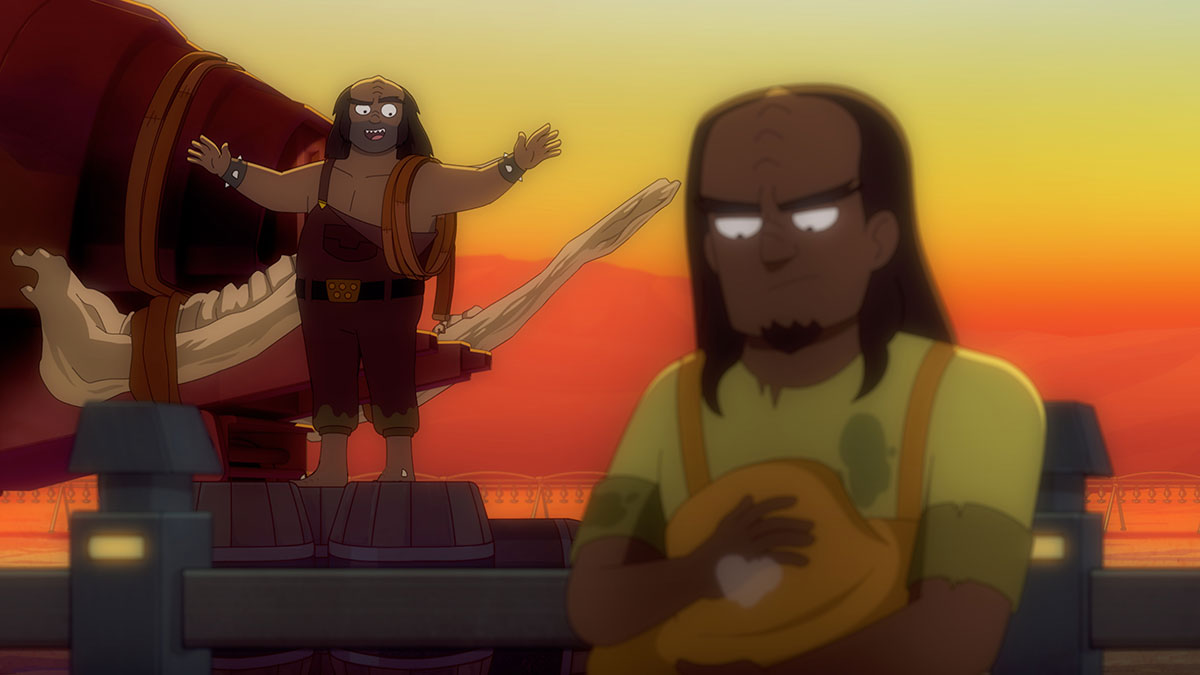
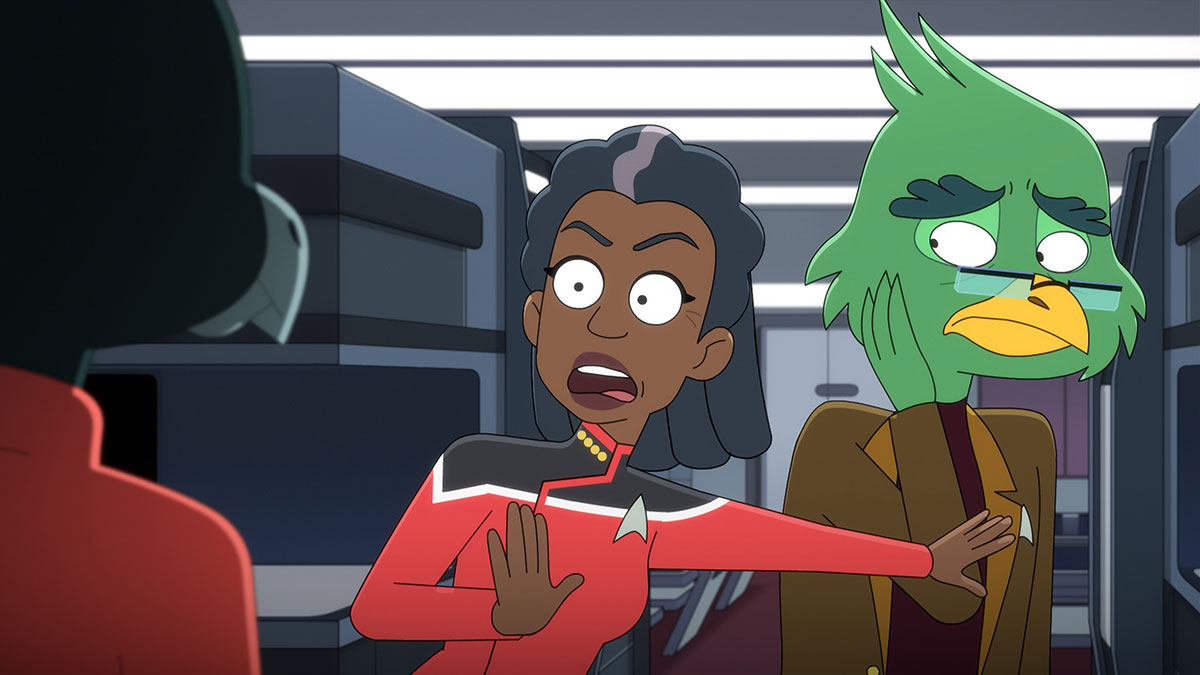
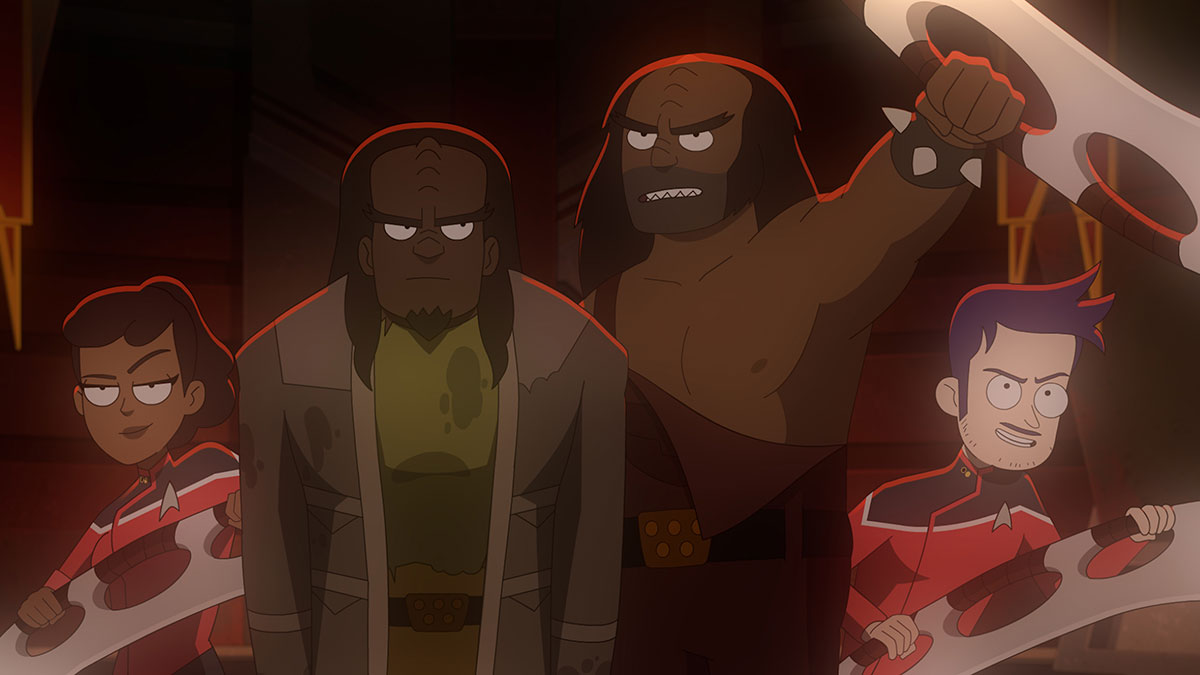
A FAREWELL TO FARMS — Dr. Migleemo cooks up some hot dishes while Mariner prefers hers served cold.
Written by Diana Tay. Directed by Megan Lloyd.
![]()
Star Trek: Lower Decks Season 5 continues with “A Farewell to Farms,” premiering November 7 on Paramount+.
Interview — Nana Visitor and OPEN A CHANNEL: THE WOMEN OF STAR TREK (Part 2)
We’re back with the second half of our lengthy interview with Star Trek: Deep Space Nine star Nana Visitor — check out Part 1 right here — the author of the new behind-the-scenes book Open a Channel: The Women of Star Trek.
In today’s conclusion, we discuss the author’s beloved character Kira Nerys, revisiting the Star Trek: Voyager and Star Trek: Enterprise eras, and more.
This interview has been edited for length and clarity.
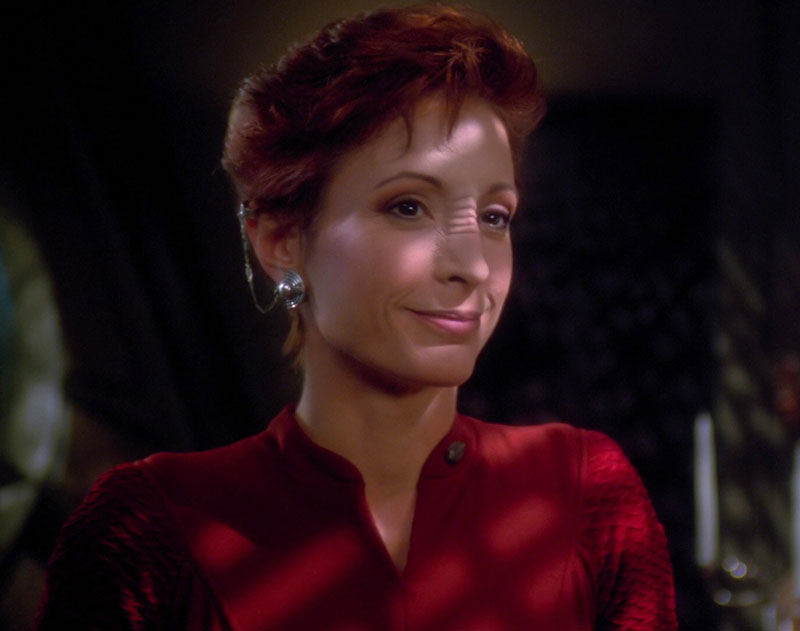
TREKCORE: Can we talk about Kira Nerys a little bit?
NANA VISITOR: Hell, yeah!
TREKCORE: You basically had to interview yourself for the book. Revisiting the character, did you think about Kira differently with the themes of this project?
VISITOR: Oh my god, yes. It’s like Kira was my chance to be the full spectrum human that I happened to be that was unacceptable at the time — but I had a chance, because she was an alien. And I took the chance. I probably ran with it a little bit, but because she existed, this stuck person that I was started thinking and behaving like Kira. Kira taught me how to be me. Does that make sense? I had the ability to think the thoughts that I wouldn’t think before, and to take the chances. That character shifted my brain.
TREKCORE: That’s what the character did to a lot of people watching too, it was just that powerful.
VISITOR: I wish I had known that at the time. I always had this feeling at conventions —there were some people who would be very appreciative but for the most part, I always felt like I had to keep my head down and go, “It’s okay.” I just felt like I needed to do it. I had to do it this way, and yet I got a lot of flack for it.
TREKCORE: What do you think changed? When did the tide turn and you start to realize you didn’t have to do that?
VISITOR: It’s like night and day. I know exactly when — once Deep Space Nine was available to watch streaming, and people saw it as a serialized show with a progression. They realized they were watching an arc and not just having this idea, maybe they watched the first episode and went, “Oh, no. I can’t stand this character.”
I remember at a convention, this 15-year-old boy came up to me and said, “I love Kira Nerys… and I have a crush on her.” And I thought “that’s so healthy.” I’m so glad to hear that, and now I meet men with wives and they have children and he goes, “I had such a crush on you, and here’s my Kira.” Saying that she is, you know, powerful..
TREKCORE: That’s wonderful. And there isn’t just one box, one type of way to be.
VISITOR: And if you don’t fit in a box, you create your own and say, “This is me.”
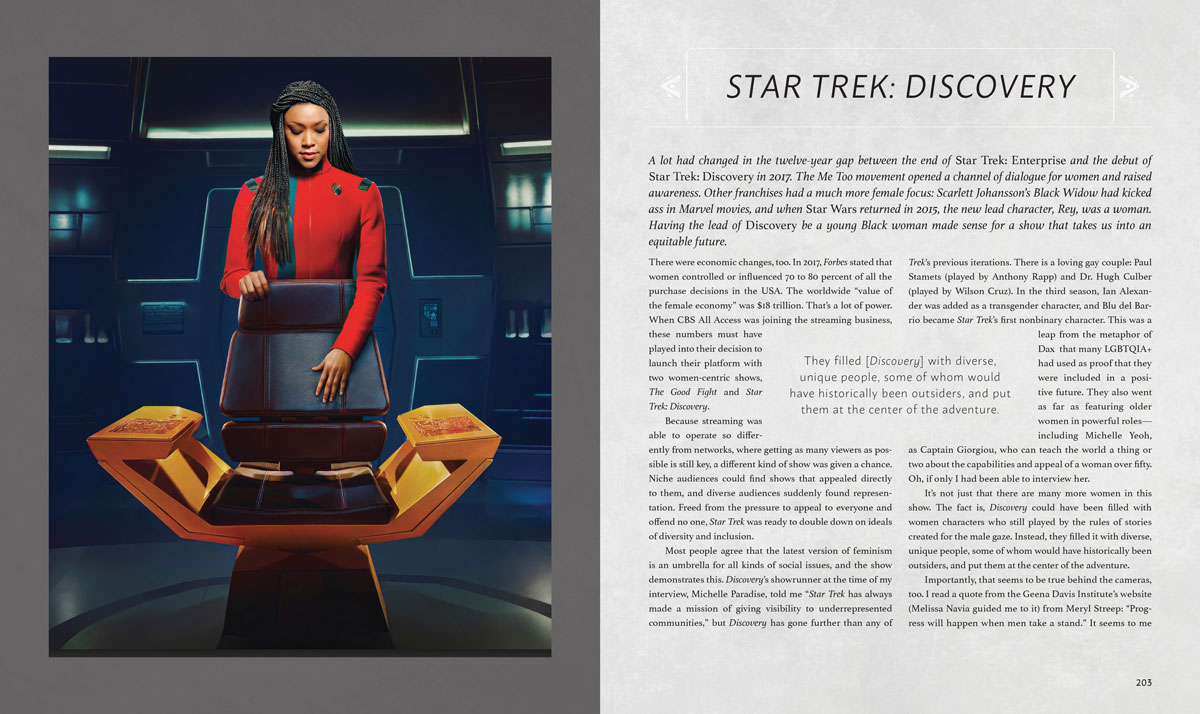
TREKCORE: I feel like that’s the message in this book too — seeing all these different examples of all these different women doing their thing. It’s an important lesson, and I think that’s the promise of Star Trek.
VISITOR: It is. And if supported by men, look, Ira Steven Behr and Peter Allan Fields did so much for my character, gave me so much room. Ben Robinson opened a door and said, “Come on, walk through it. Walk through it. You do it.” It’s huge. That’s the only kind of door opening we need.
TREKCORE: And leaving the door open for more people.
VISITOR: Leave it open for the other women to come through too, all of us.
TREKCORE: I found it really interesting when Roxann Dawson spoke about directing; how she said you have to be perfect, because you’re representing all of the women in the whole world. Like if you mess up, they’re gonna say, “That’s it. Women can’t do this.”
VISITOR: She is an amazing woman and incredibly strong. And to hear how she had to fight to be a director you go, “I understand why she feels that way.” But you can’t bear that weight when you get creative. You can’t bear that. And there’s not a job that isn’t creative that you don’t need all of your brain for. And if much of it is fearful, you’re screwed.
TREKCORE: How do you feel being a mentor for-for so many women like this?
VISITOR: I think that as an elder, that is my joy and my curiosity, and it feels like the connection I want so much. I want to see young women have an easier time. They are, but even more so. I see the stress and I see the worry and there’s so much that is unnecessary, you know? And just having someone who’s been through it before, but also it’s a conversation because a young woman can tell me, “No, no, that’s not what we’re dealing with anymore.” I need to shift my thinking. [laughs] It’s a two-way street.
TREKCORE: Right. It has to be beneficial for both parties and they’re dealing with different challenges than we did, right? I think this book is very instructive in that. I really enjoyed hearing from the younger women on the newer shows.
VISITOR: Me too. But we need to know history, we need to know recent history that women said, “That’s just the way it is,” or, “That’s just the way it was.” We need to keep that in mind, because Voyager to Enterprise, right? We need to keep things moving forward.
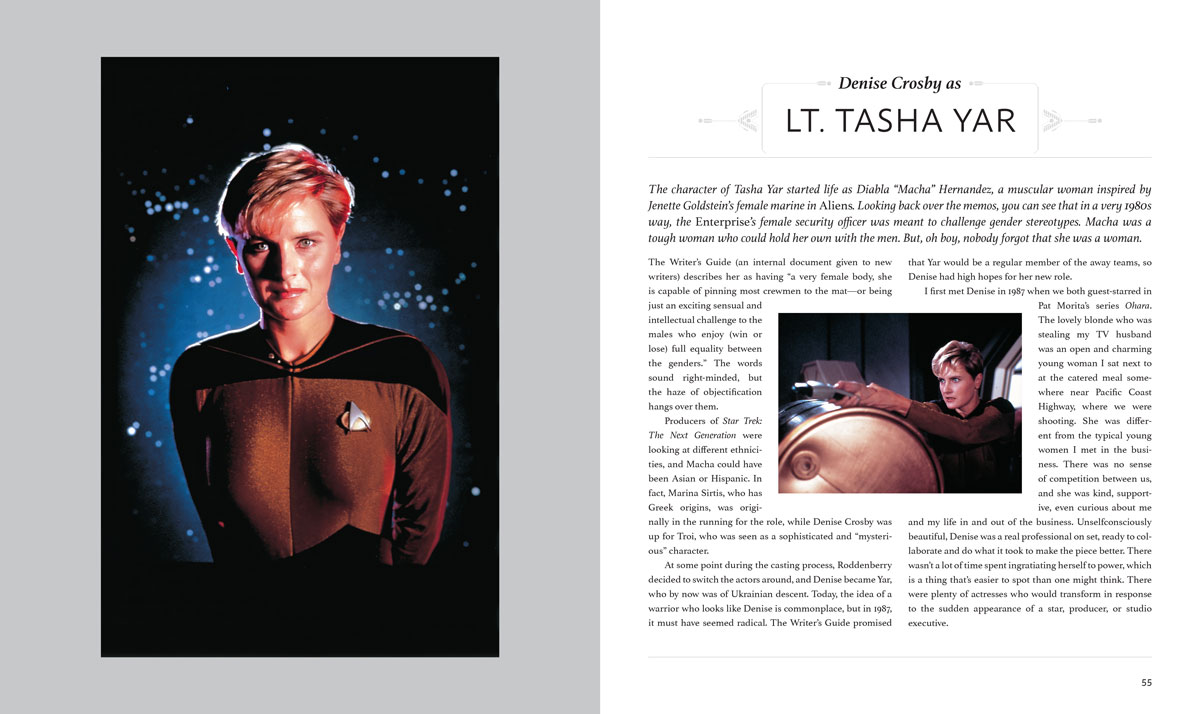
TREKCORE: It’s so interesting, as you mention in the book, that nobody mentioned T’Pol or Hoshi to you as characters that were inspirational to them.
VISITOR: Not that I can recall. However, I understand how important — from Linda’s other interviews — how important it was that there was Asian representation in any way on the show.
TREKCORE: Yes, Hoshi is an important character in that respect. I think the biggest thing you could say about Hoshi is that we didn’t get enough Hoshi.
VISITOR: We didn’t get enough Hoshi. I think it was maybe, in my opinion, too soon to give the woman the terror of being in space. That would read differently now. I think it was too soon. I think a man, we could just see it as a human thing that would happen that they would be terrified, you know. But it was too laden at the time for it to be a woman.
TREKCORE: Yes. And I don’t wanna be too harsh on Enterprise. I’m actually a big fan of Enterprise.
VISITOR: A lot of people are. And here’s the thing, they did have some women writers, didn’t they? They had some women writers. But there’s — and one of them told me this — she basically said, “I can have the most progressive idea for a script, but if the person at the top doesn’t want that, it’s not gonna happen.” So you need to have women and then they need to be given the full spectrum of what they want to do.
TREKCORE: So you watched a lot of Star Trek for this book.
VISITOR: I did.
TREKCORE: And you watched with a real critical eye.
VISITOR: And that’s really important because I had the lenses on my eyes of what was this like for women. So it doesn’t mean that Enterprise, if you’re just watching it, you know, falls down in any way. It just means through my eyes, watching for women specifically for this, I go, “Well, wait a minute. This isn’t great.” So that’s important to remember.
TREKCORE: Did you have any surprise favorites? Any episodes that stood out or characters or shows in particular that stood out for you?
VISITOR: Quite a few. I was shocked how good it all was. But I’ll say the character of Seven of Nine. Talk about unconscious bias. Before I watched it, just from what I saw in posters and stuff, I thought I knew what it was — and I absolutely did not.
TREKCORE: You described her as a Trojan horse in your book.
VISITOR: Yes. That character is a Trojan horse. I found that all very, very powerful. That was a real shock to me. Also Strange New Worlds. I resisted watching it but my gosh, it’s so good. I think it’s so good. And I find that Pike is exactly the kind of leader that I would love to see in most hierarchies.
He has an idea of what he thinks, but he takes everybody’s advice in and it’s not about ego. It’s about what’s best for whatever mission or whatever person he’s talking about. I love that example. I think he’s wonderful. Anson Mount is wonderful in it. And I love that no one looks like each other. And they’re all honored for what and who they are. It’s so refreshing.
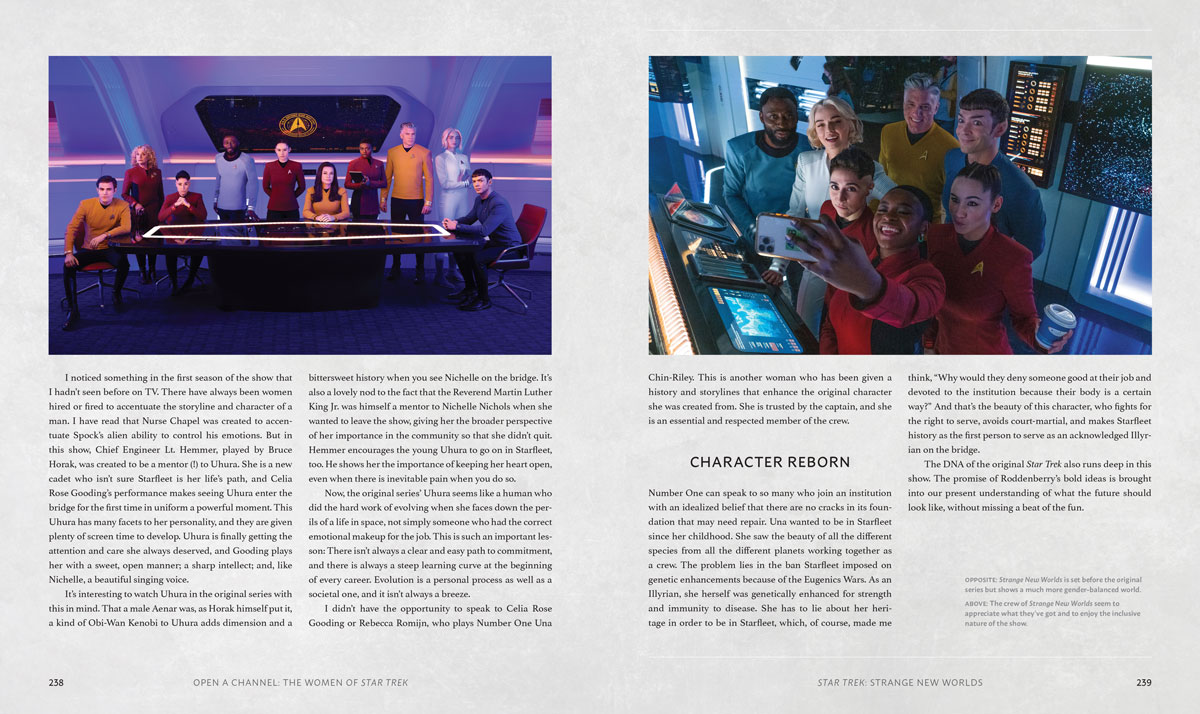
TREKCORE: When you revisited Deep Space Nine, did anything strike you as like, “Oh, I don’t remember that,” or “Oh, this was a good one. I did great in this one,” you know?
VISITOR: Oh yeah. It was a lot that I didn’t remember — and don’t forget, at the time we were filming I didn’t record them and watch them, it was just like everybody else, it was catch-it-if-you-can. I was floored by the writing after so many years of being away from it, floored by the writing and how it stands up and how it’s appropriate to our times right now, 30 years later.
TREKCORE: That’s why Deep Space Nine’s the best.
VISITOR: The writing is incredible. Truly incredible. Ira was another one who was so generous with his time in letting me interview him and his wife — who is a force to be reckoned with, and had so much to do with me not having to hide my pregnancy, which was huge.
TREKCORE: That must have been so important to you.
VISITOR: That was was a big shift because I was sure I was gonna get fired. Because you get pregnant, you could get fired. That changed everything for me to go, “I can have a life and a job.” We’re still not there with everybody. It’s a struggle.
It’s a question I asked everybody. What should Star Trek do with childcare? Let’s talk about it because Star Trek has answers for everything. That’s something that we need a little 1,000 years ahead advice about.
TREKCORE: The way they decided to incorporate your pregnancy in “Body Parts” was just such a delightful sci-fi premise. It wasn’t about hiding your pregnancy, that it was just like, “Let’s come up with this little switcheroo.”
VISITOR: It was brilliant because then they wouldn’t have to deal with me raising a child and being my character. It was brilliant. Really brilliant.
TREKCORE: What was the experience of filming the birth (in “The Begotten”) like?
VISITOR: The only thing I remember really, really specifically is I had already had Django. The child I was carrying was recently born. So, I wasn’t pregnant anymore. I was wearing something to make me look pregnant at that point. Although I gained 60 pounds, so they really didn’t need the padding. I was still well padded.
But I was hormonal and enraged because they had such a young baby and they smeared it with what looked like cream cheese and raspberry jam and the baby was shaking. You know, it’s cold on the set. Shaking. And they have baby wranglers, so the mother’s not allowed to touch the baby when it’s working. And I just was beside myself about that.
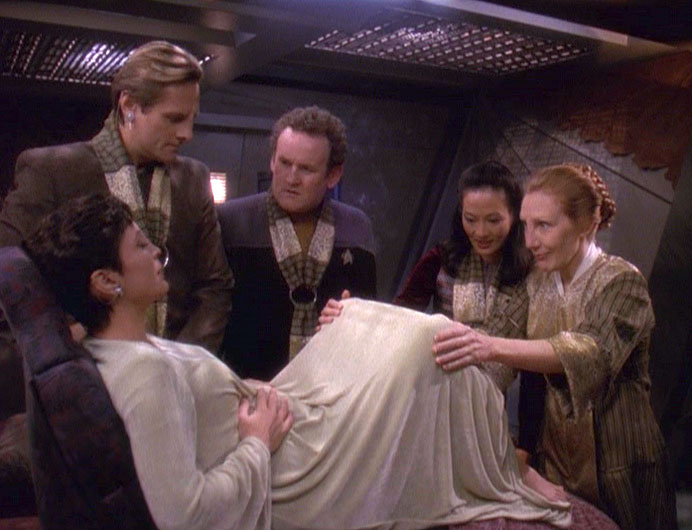
TREKCORE: That’s terrible!
VISITOR: Yeah, it was terrible. It was a terrible experience. I’m going, “Look, just make an animatronic. Just make a doll!”
TREKCORE: I’m gonna look at that episode in a new way! [laughs] Well, thank you, you’ve been so generous with your time. I really appreciate it. This has been such a joy for me.
VISITOR: For me too. And I’m so glad that you enjoyed the book.
![]() Open a Channel: The Women of Star Trek is in stores now.
Open a Channel: The Women of Star Trek is in stores now.
STAR TREK: PRODIGY 217/218 Review — “Brink” and “Touch of Grey”
As we near the end of Star Trek: Prodigy’s story, “Brink” and “Touch of Grey” lay the groundwork for the finale. “Brink” feels a little like a placeholder — albeit an entertaining one — meant to get the pieces where they need to go. “Touch of Grey,” however, is among my favorites of the season: we are still moving pieces, but the rescue is thrilling and the interactions between the characters adds so much depth and vibrancy, elevating the whole endeavor.
“Brink” opens with a flashback of Asencia (Jameela Jamil) working to harness the power of the wormhole. Her lab is full of really interesting looking equipment and panel displays that her scientific henchmen are using to try to figure out how to stabilize the experiment. Enter Wesley Crusher (Wil Wheaton), who issues her a warning about the dangers of time manipulation before he gets easily captured.
I was relieved to find out later he did it on purpose, because catching a Traveler shouldn’t be that easy. And that is the missing piece she needs: Asencia’s breakthrough is Wesley Crusher’s thoughts. What a fiendishly cruel and clever plan!
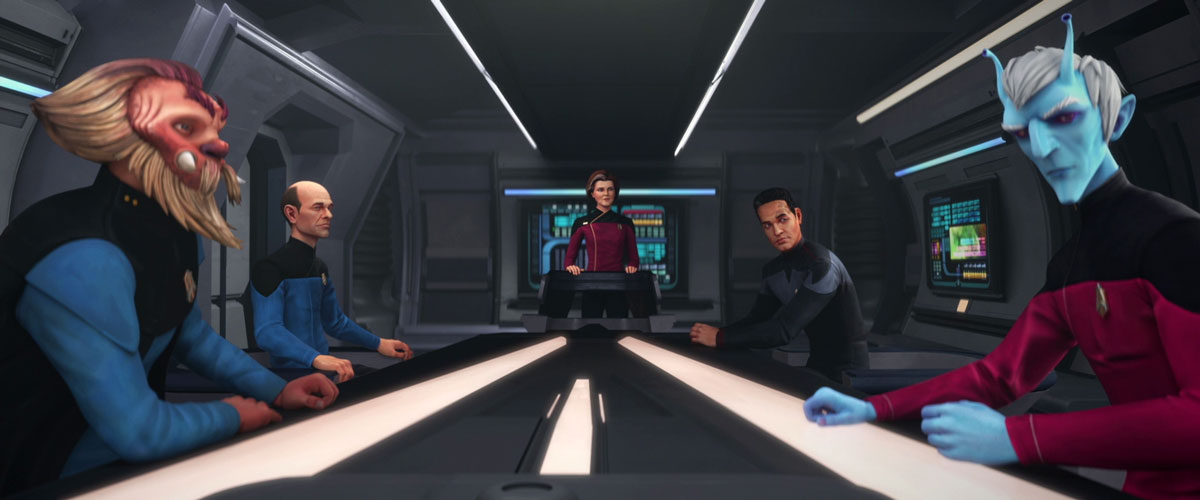
Admiral Janeway (Kate Mulgrew) and her senior staff have a classic conference room strategy session, and it’s so soothingly Star Trek. Even more so when Gwyn (Ella Purnell) chimes in with her ideas. When Doctor Noum (Jason Alexander) quips, “Who invited the kid to the adult table?” it’s incredibly satisfying when Gwyn shuts him down with a quick: “The Admiral.” Gwyn’s poise and confidence in this scene is a well-earned delight.
Her reasoning is sound. She offers her team to go in and get the intel Janeway needs on Asencia’s time-space manipulation weaponry — off the Starfleet books. It’s a nice way to go around Admiral Jellico’s orders without technically breaking them (or the Primer Directive)l, and a perfect excuse to give our crew what would otherwise be a decidedly adult-level away mission. I love that Prodigy gives us the ability to indulge a little in what these kids would truly be allowed to do in a somewhat credible manor.
Solum is once again stunningly gorgeous, helped rather than hindered by the addition of Asencia’s temporal accelerant vaults, the fury of motion inside which move in a smooth ballet of technology. However, now Drednoks and Watchers patrol the streets, adding a sense of oppression to Asencia’s takeover.
Our gang moves under the Star Trek version of an invisibility cloak, which delighted my kids. My kids’ obvious reference for this is Harry Potter, but I did remind them that Star Trek has had cloaking technology since before Harry was born. The contrast was interesting to them — my son mentioned that it was cool that in Harry Potter, the cloak was magic and here, the cloak is science. I love that… and magic or science, it’s really fun! The visuals here are hilarious and really cute, as such a motley crew of aliens shuffle close together to try to stay under the invisibility bubble.
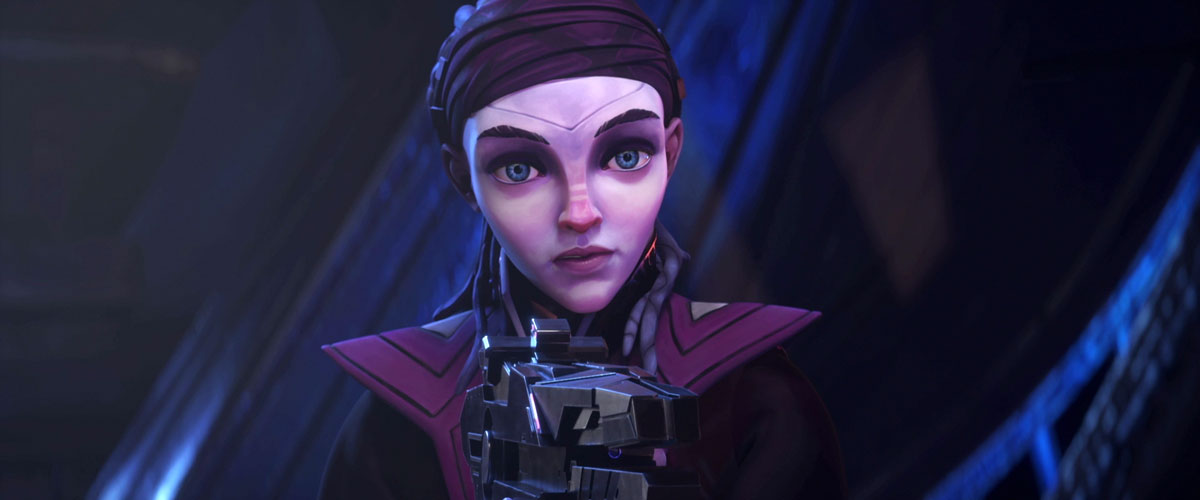
They arrive at Ilthuran’s place, searching for clues to his whereabouts, and are surprised when someone discovers them. Jankom’s (Jason Mantzoukas) scream of “Starfleet disavows us!” really made me laugh. Surprise: it’s Asencia — not the Vindicator, but rather young Asencia from this time period. What a thought provoking addition to the story! Seeing the absolute worst version of yourself has got to make you pretty introspective, so it makes perfect sense that she would be a leader in the resistance. She lets the crew know that older Asencia has Wesley Crusher prisoner and is draining his mind of secrets.
Choose your own adventure time for our away team leader, Gwyn: Do they rescue Ilthuran or Wesley Crusher? There isn’t time to save both, who is more important? Gwyn chooses to ignore this particular version of the trolley problem all together. No one will get left behind. They will split up to save both.
Dal (Brett Grey) disagrees, stating that they should stick together and that they only have one site-to-site transporter. But Dal shows exactly show far he’s come when he respects the fact that Gwyn is in charge and supportively follows her orders. This was a really fun thought experiment for my kids as they decided what they would do if they were Gwyn. For the record, there was one vote to rescue both and two votes to rescue just Wesley — sorry, Ilthuran!
More fun invisibility cloak hijinks as the group of Gwyn, Rok, Zero, and Murf go off to rescue Wesley. The gravimetric distortions have the cloak on the fritz as the guards, who keep getting glimpses of the crew, walk right up to the edge of the cloak. Rok (Rylee Alazraqui) bonking the guard on the head with the cloaking device is satisfying both visually and with the fantastic “clonk” sound that it makes. My kids all cracked up.
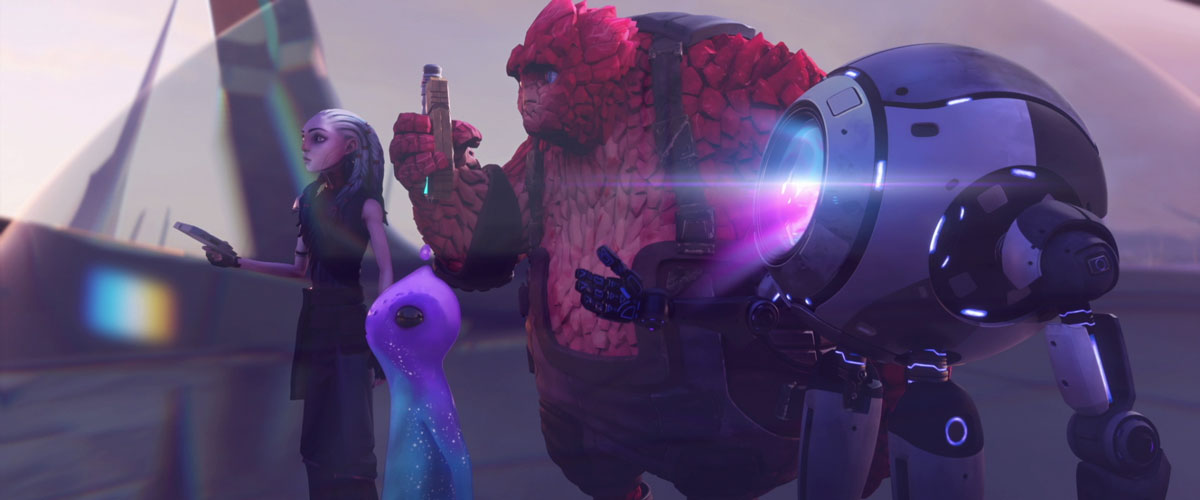
Meanwhile, the other group, Dal, Jankom, and Maj’el (Michaela Dietz) — along with young Asencia — find Ilthuran (John Noble) on a relocation train. They rescue him and the council members. The irony of our crew breaking The Diviner out of prison is not lost on me!
After some more close calls and hijinks, the first group makes it to Wesley — who was expecting them. He reveals that getting captured was his plan to get Asencia to develop the wormhole tech they need to send the Protostar back to Tars Lamora. Bold move, but I guess the fate of the entire timeline is at stake here. When Wesley finds out they split up, he freaks out, as his plan was contingent on them sticking together. Zero (Angus Imrie) speaks for all of us when they say: “We thought you meant team spirit!” Apparently, what Wesley meant was never separate. Oops!
Now they are in uncharted territory, and Wil Wheaton’s delivery of the line “I am lost” is chilling. That is not something you want to hear from your typically ace-in-the-hole extra-temporal being. And it gets even more dire as he gets the last line of the episode: “We’re all in danger and I don’t know what happens next.” Not good! “Brink” ends with Wesley and Ilthuran using the site-to-site transporter back to Voyager, while the Protostar crew is back together… as Asencia’s prisoners.
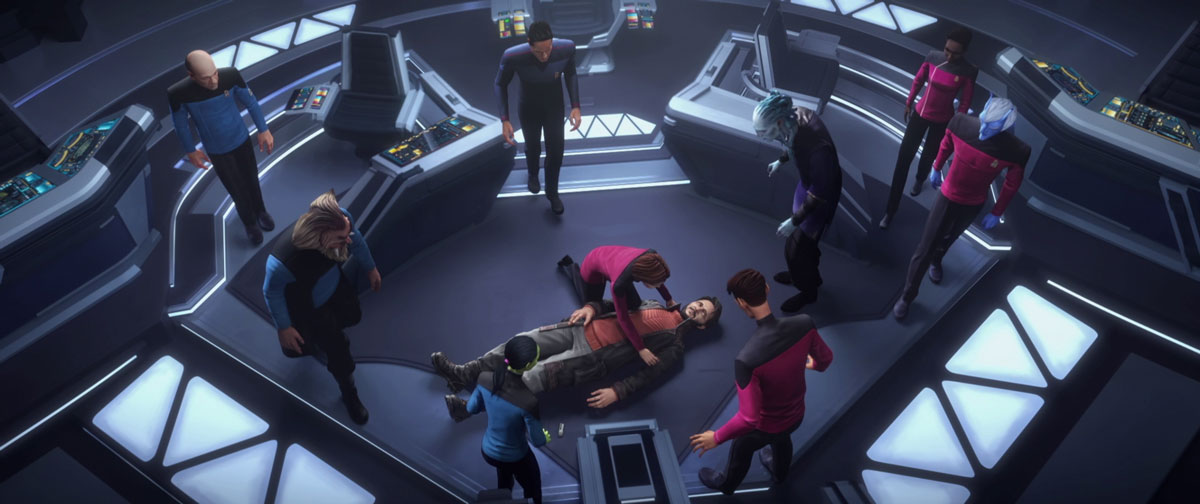
“Touch of Grey” starts off slightly before the end of “Brink”, where Janeway is anxiously awaiting news from the Protostar crew. We get treated to a lovely conversation between Janeway and Chakotay (Robert Beltran). Maintaining his character trait of gifting Janeway meaningful, symbolic gifts, he gives her an original Voyager-style combadge. It’s the 14th anniversary of her first command, of the start of their journey together.
Although sadly, for Chakotay, it’s been 24 years, as we are reminded of his ten years marooned on Ysida. The dialogue flows so easily between the two here, it’s really one of the best versions of their new dynamic. I’m not saying they are turning me into a Janeway/Chakotay shipper, but I really enjoy the ease and comfort between these two characters who deeply love each other at this stage of their lives.
We get a replay of the final scene from “Brink,” and it’s very effective to get both sides of this coming back together. Wesley gets sent to sickbay and it looks like Asencia’s torturous mind extraction has left him temporarily powerless. A great way to remove an OP character’s advantage. Asencia herself is in peak form, as she publicly goads Janeway into coming to Solum, less something happen to our beloved Protostar crew.
Her demagoguery against offworlders in general — and the Federation in particular — is bone-chilling in its manipulative phrasing and delivery. Please, someone give Jameela Jamil all the awards for elevating this villain way beyond a typical cartoon bad guy.
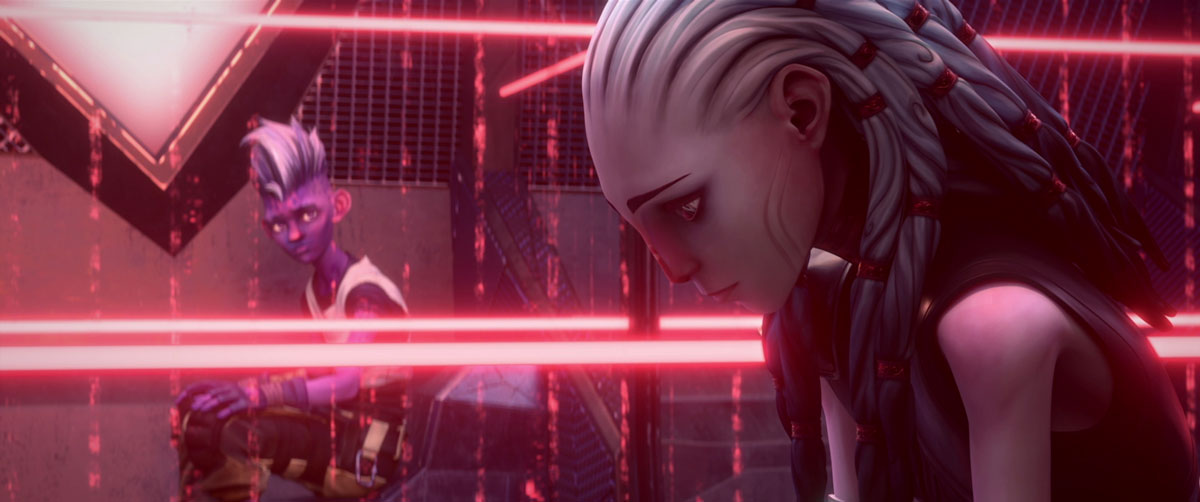
Tysess (Daveed Diggs) advises her not to go, but it looks like we are getting the band back together, as Chakotay and the EMH (Robert Picardo) both agree that they are down for a rescue. Wesley Crusher is coming too, and the very idea of an away team featuring these four legends seems almost too good to be true.
Apt that this particular away team uses the Protostar’s vehicle replicator to build a ship to sneak into Solum, as they lost so many shuttles on the original Voyager. While it builds, we get to see what Hologram Janeway has been up to — which is apparently reading EMH holonovels. You can almost hear the smile on Kate Mulgrew’s face as she delivers Holo-Janeway’s fangirl lines complimenting our dear doctor. Such a cute little scene!
We get some more fantastic Solum scenery, as Asencia has trapped our crew in what appears to be old ruins of ancient Solum. Her plan for the crew becomes clear as a platform opens up to reveal a Loom. Seeing this one in such close quarters really shows off the amazing creature design of these time devourers. The danger is palpable as the crew back away and run around avoiding the monster. The arena feels like a video game stage as they dodge the beast, once again reminding my kids of Breath of the Wild and bringing back their nickname for the Loom: “Time-Blight Ganon.”
The arena itself looks just as impressive from the outside, as the away team looks on and strategizes a rescue plan. It’s just such a gift to hear Admiral Janeway’s pep talk to Wesley and her orders to all as they prepare to engage. Wesley and Chakotay’s little heart-to-heart also increases the emotional impact of having these characters back.
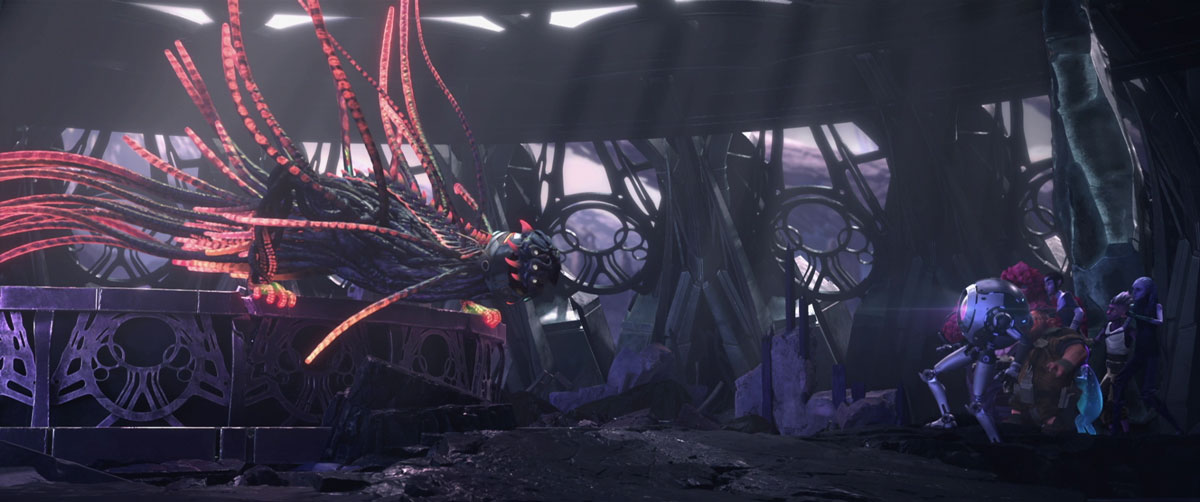
Janeway boldly goes to confront Asencia, and offers a trade of her for the crew. Asencia finally does something that most fictional villains never do: stops dawdling and starts shooting. She phasers the Admiral! Now, I knew that this was not how they would kill off Admiral Janeway, but it was still shocking to watch her go down. Luckily we didn’t have to wait long to learn that it was really the EMH impersonating Janeway. My kids thought that was so clever, and they laughed at his dramatic overacting during his big death scene.
Chaos ensues as Janeway uses her combadge to scramble signals, releasing the Loom. Asencia looks frightened for the first time since we’ve met her after she discovers the EMH’s trick and the Loom bares down on her henchmen. She is incredibility frustrated as our rescue team and Prodigy crew escape in their shuttle. And more bad news for her as Ilthuran makes a broadcast opposing her as she receives reports of people rising up. It sure is a different way to go into a finale, with the villain not having everything falling into place.
The episode ends and leads into the finale with a gem of a scene on the way back to the Voyager-A. The configuration inside the shuttle really gives the feeling of loading the kids into the minivan, with Mom Janeway and Pop Chakotay in the front. The trip is full of heartwarming interactions between our new heroes and seasoned legends, and it’s fun to watch Rok fanning over Wesley’s tech use.
Maj’el responds to the EMH’s loquacious holonovel title in a way that could have come straight out of the mouth of Tuvok. Our core four of Janeway, Gwyn, Chakotay, and Dal have a wonderful discussion about what’s next, and everyone is on the same page. What needs to be done in the finale is clear: let’s save Solem AND the timeline. Stopping a civil war AND saving an entire universe from blinking out of existence? Not too shabby for a “kid show”!
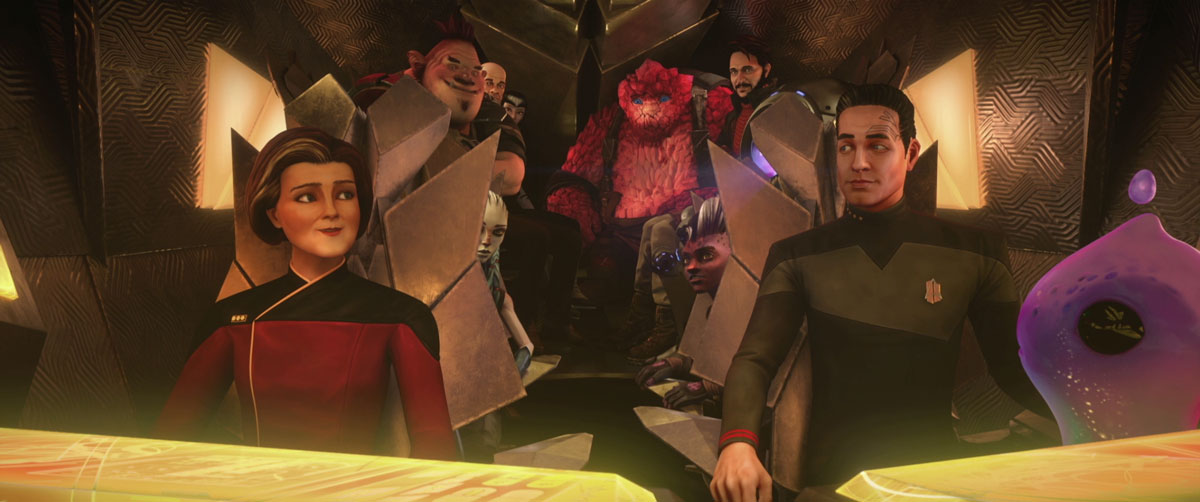
“Brink” and “Touch of Grey” line up everything perfectly for what is sure to be an epic finale. Satisfying rescues and action and lots of wonderful character interactions. After 18 episodes, the season feels exceptionally “lived in”. This is one incredibly dense season of television, yet not overwhelming at all, even for my kids. They are all in. They know the players and they know the stakes and are ready to see how it ends.
![]()
Star Trek: Prodigy Season 2 is available to stream now on Netflix globally (excluding-Canada, Nordics, CEE, Netherlands, Spain, Portugal, Poland, Russia, Belarus, and Mainland China). The show can also be viewed on SkyShowtime in the Nordics, the Netherlands, Portugal, Spain and Central and Eastern Europe.
STAR TREK: LOWER DECKS Review — “The Best Exotic Nanite Hotel”
Star Trek: Lower Decks takes the chance to correct an error in judgement about one of its character relationships by lovingly poking fun at itself — and creating plenty of opportunities for awkward humor along the way — in “The Best Exotic Nanite Hotel.” While not quite as strong as the first two episodes of the season, there is plenty to like in both subplots of this episode, which see Mariner and Jennifer reunited and fun with Boimler and Ransom.
Many fans had been disappointed when the relationship between Mariner (Tawny Newsome) and Jennifer (Lauren Lapkus) was unceremoniously dropped after Jennifer refused to side with Mariner in Season 3’s “Trusted Sources.” Given how few LGBTQ+ relationships there are in Star Trek, a lot of fans had been hoping for better.
That didn’t necessarily mean that Jennifer and Mariner needed to be together — as established in this episode, it’s probably better that they aren’t — but the dumping of the storyline did not sit right with a number of fans.
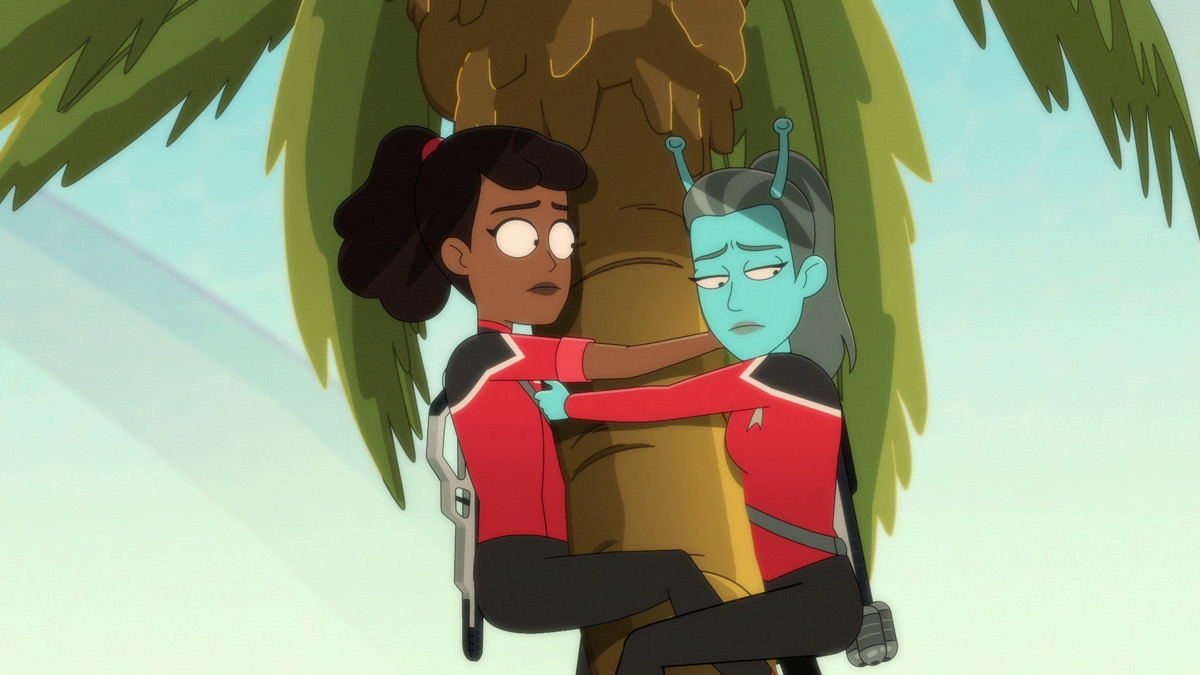
Which creates the perfect entrée for “The Best Exotic Nanite Hotel,” whose premise is that Mariner just dropped her relationship with Jennifer in the same way the show did. Now reunited before Jennifer transfers to the USS Manitoba, Jennifer pretends that she still thinks her and Mariner are an item to extract maximum discomfort.
I will certainly confess to being someone who does not do well with emotional conversations, so I understand Mariner’s inclination to let a wordless brush by stand in lieu of a true break up. But the moment of catharsis for the two characters where Jennifer apologizes for how she treated Mariner and their astute recognition of why they are poorly suited for each other was the kind of mature depiction of a mutual end to a relationship that I don’t feel like you see much of on TV.
The nanite plot was fairly rote outside of the Jennifer/Mariner dynamic, but discovering T’Lyn’s (Gabrielle Ruiz) love for Krog and his vibe tubes was pretty delightful. Lower Decks has a very clear ethos around being junior, but it also has a very clear ethos about the joy of being a fan of something, and the show always nails the message that it’s good to love things, and anyone can. Even a Vulcan!
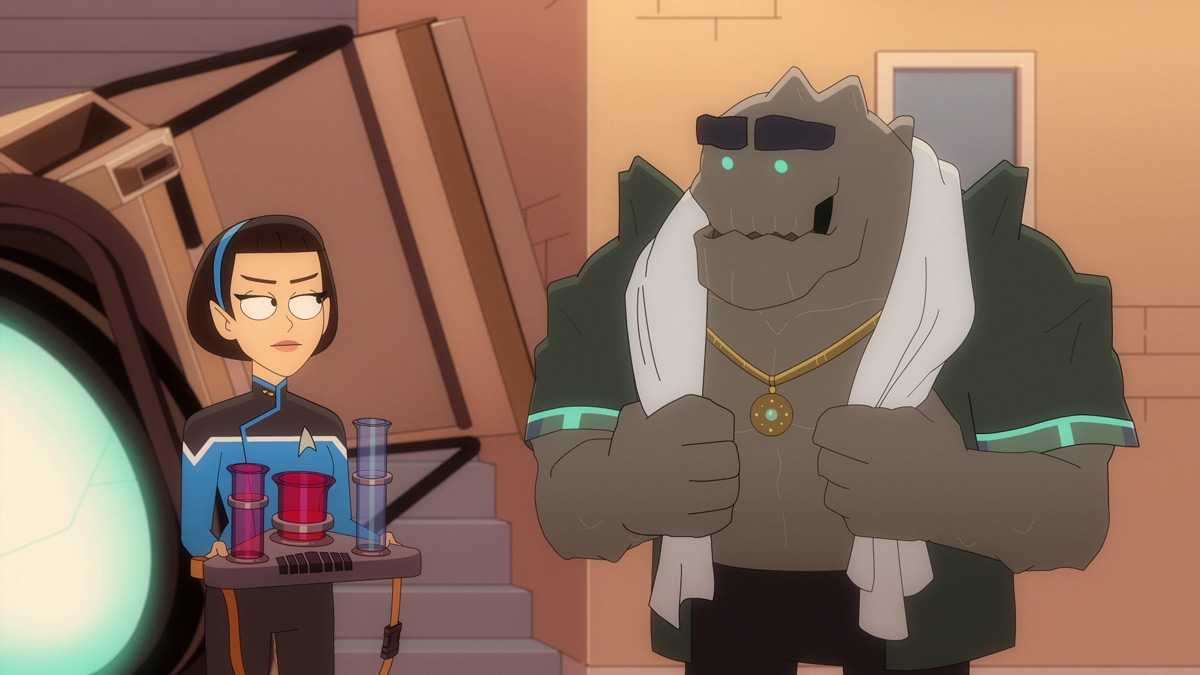
The Boimler/Ransom/Billups story also has its charms, as Boimler (Jack Quaid) continues to grow his confidence, though the absurdity of the plot coupled with the absurdity of the very large ball of nanites did feel like it strained credulity a few times. Lower Decks thrives when it’s stretching the credulity of Star Trek without breaking it, but you could hear the faint cracking of the “Starfleet wants to arrest an admiral who is burned out and a little resentful of his dead end job” set up.
This episode does appear to confirm, though, that the quantum fissures will remain a plot point through the season. I would have liked to see a little more of the “One Little Ship”-style USS Endeavor, but that was a surprising resolution to the rampaging nanites that I thought was a lot of fun.
TREK TROPE TRIBUTES
- The episode’s subplot with Ransom, Billups, and Boimler plays with the Trek Trope of a Starfleet officer who goes to an alien planet and then prefers to stay there rather than returning to Starfleet, like Captain Tracey in “The Omega Glory.”

CANON CONNECTIONS
- A nanite cluster consuming a ship’s raw materials to expand their size and evolve was the premise to the Star Trek: The Next Generation episode “Evolution.”
- Boimler muses whether they will have to wear the black bodysuits seen in undercover away missions like that in “Chain of Command, Part I.”
- We finally get to see the Gallamites and their transparent skulls. Gallamites had previously only been referenced (a lot) in Star Trek: Deep Space Nine, in reference to the charming Captain Boday who dated Jadzia Dax, among others.
- We also see the Kreetassans, of “Vox Sola” and “A Night in Sickbay” fame/infamy.
- The vibe tubes were previously seen — but not named — being played by a musician at the Café des Artistes in “We’ll Always Have Paris.”
- Boimler asks Admiral Milius (Toby Huss) whether his space-whale milking duties were in reference to the gormagander or the “Galaxy’s Child” space creatures.
- The other universe’s Intrepid-class USS Endeavor, commanded by Captain Tersal, still uses the TNG uniform style.
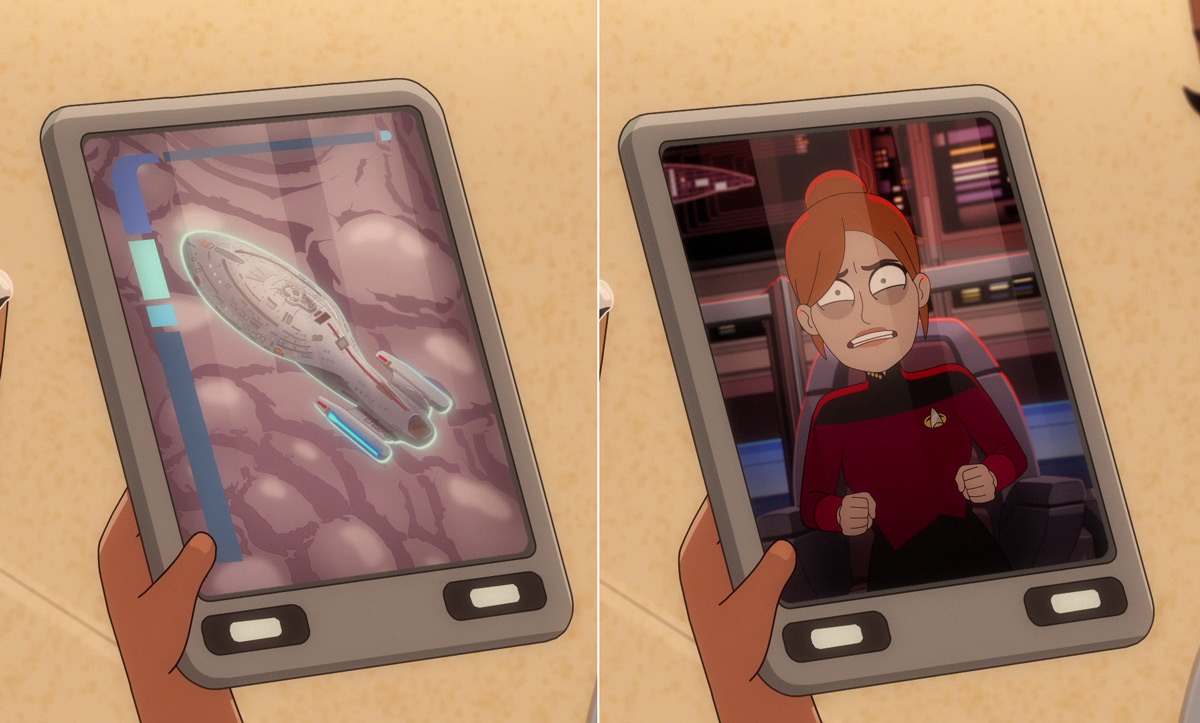
OBSERVATION LOUNGE
- This episode’s title is an homage to the 2001 film The Best Exotic Marigold Hotel.
- Admiral Milius is likely named for screenwriter John Milius who wrote Apocalypse Now.
- The Cosmic Duchess hotel looks to be based off the design for Starbase 1 seen in Star Trek: Strange New Worlds.
- The crew’s nanite-collection vacuum backpacks bear a striking resemblance to Ghostbusters proton packs.
- Boimler’s beard doesn’t seem to be growing very fast.
- “Despite the increasing in cheering, your presence is a comfort,” is probably the nicest thing T’Lyn has ever said to anybody.
- Given the USS Vancouver and USS Toronto were both Parliament-class ships, one would assume the USS Manitoba is as well, even though it is never seen.
- Billups orders a Silurian Colada, which may be a winking reference to the sea-dwelling race in Doctor Who.
- Propinquity is “nearness in space and time” according to Merriam-Webster.
- An icosahedron has 20 faces.
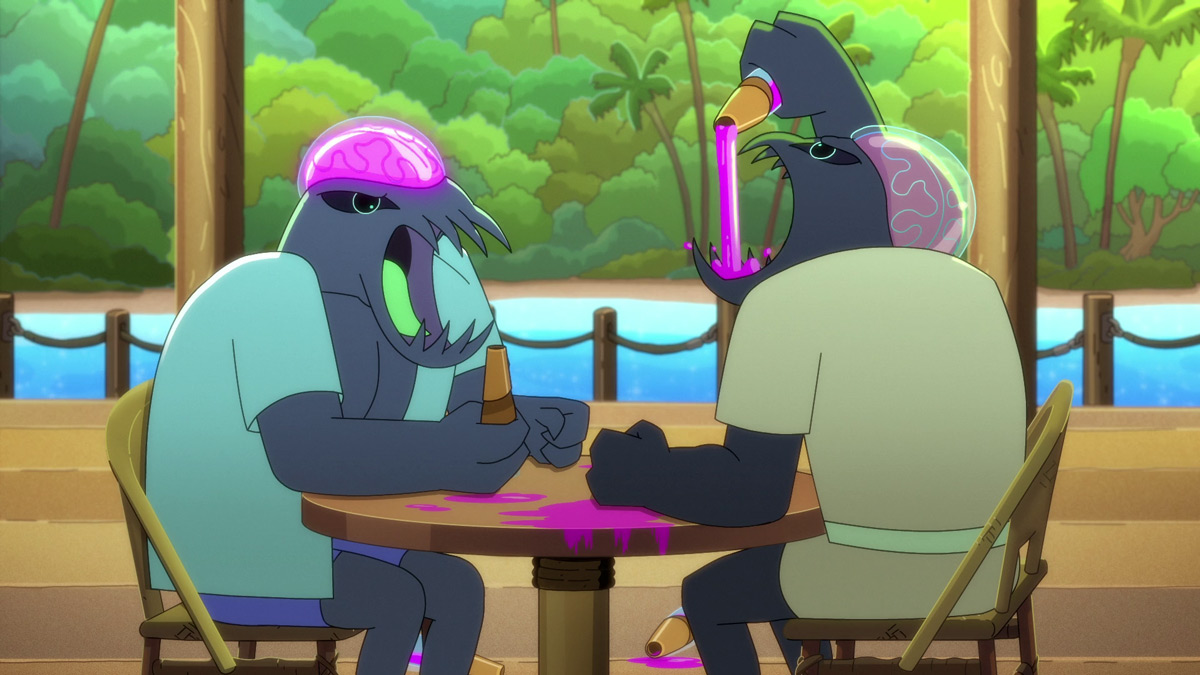
“The Best Exotic Nanite Hotel” has good vibes, but doesn’t quite hit the high notes of last week’s opening two episodes.
It veers a little too far into the absurd for my tastes, but there’s a lot to like in both the Mariner/Jennifer dynamic, and in Boimler slowly evolving into his bearded alternate universe counterpart just as slowly as his actual beard is growing in.
![]()
Star Trek: Lower Decks Season 5 continues next week with “A Farewell to Farms,” premiering November 7 on Paramount+.
Interview — Nana Visitor and OPEN A CHANNEL: THE WOMEN OF STAR TREK (Part 1)
In Nana Visitor’s new book, Open a Channel — The Women of Star Trek, she weaves together tales from women of every incarnation of Star Trek into a rich tapestry of trials and triumphs. By centering both the characters and the unique women behind the roles, Visitor explores both the history of women characters in Star Trek, and even more deeply the experiences of the women who brought them to life throughout decades of Hollywood and how each era shaped the women who worked and lived through them.
We were lucky enough to get a chance to sit down with Visitor — who of course portrayed Kira Nerys on Star Trek: Deep Space Nine — to talk about the extraordinary experiences she had creating this work and what she learned along the way.
This interview has been edited for length and clarity.
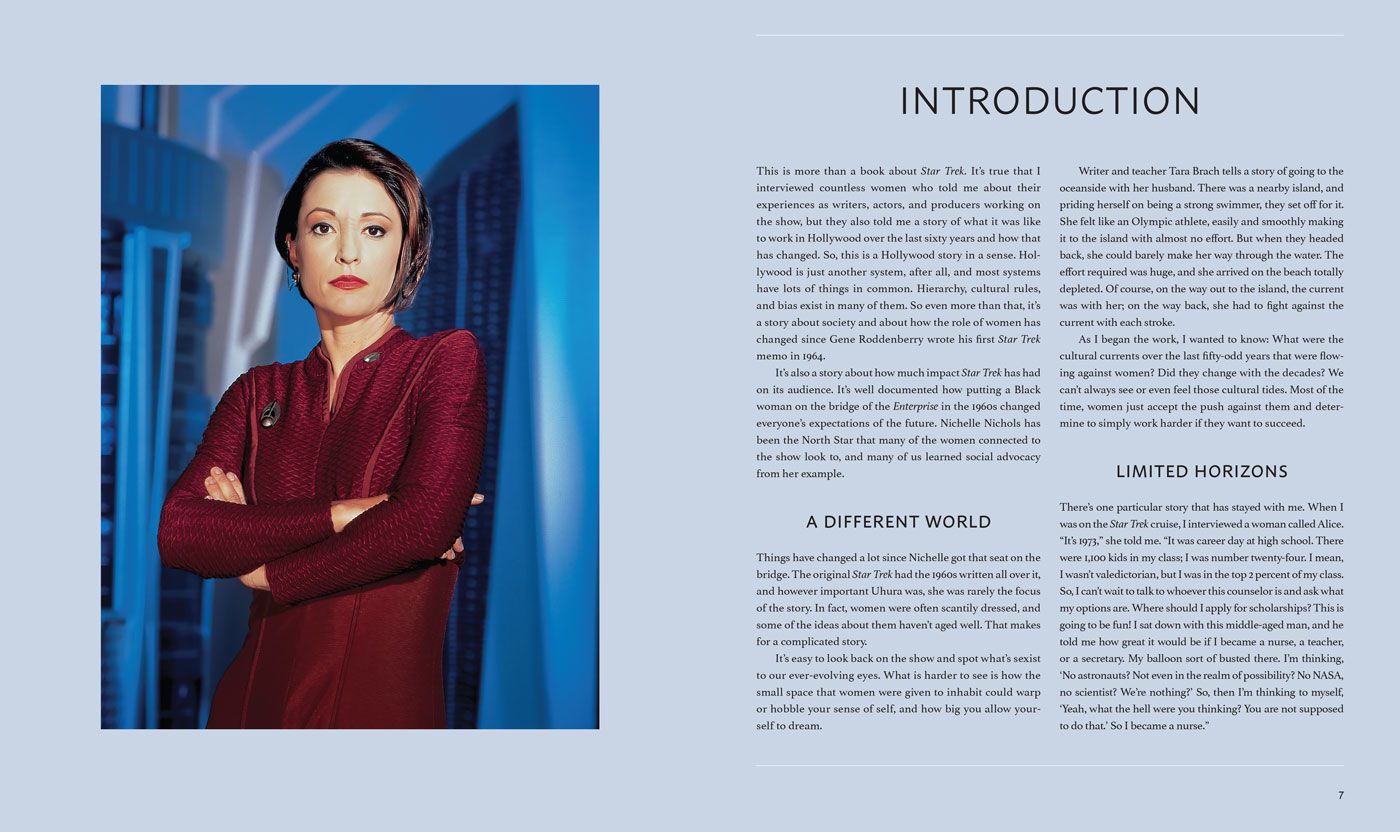
TREKCORE: Let’s start from the beginning. Where did the idea come from, and how did you decide to take on such a big challenge? It’s a really big scope, almost 60 years of Star Trek.
NANA VISITOR: I have to tell you, I spent most of the time overwhelmed going, “I don’t know where to start or keep going,” you know, it was so much. Ben Robinson thought that having a book on the women of Star Trek was a really strong and timely idea, and he came to me and said, “Would you write it? It doesn’t make sense for a man to write this.”
And it was originally going to be a page each of all the women, the actors, what they represented, who they were, maybe some kind of representation of them artistically on the other page. And as I started to think about it, and it was mostly, I guess, subconscious, this desire to go, “Wait a minute, what about — ” To his credit, he let me go. It wasn’t the book that it started out to be.
It was supposed to be really what you think of a coffee table book being, but as I started to think about our lives, the decades we were in, what we dealt with as we were projecting this hopeful future, it seemed I couldn’t see another way to put it down. I thought that was really, really important to say.
TREKCORE: You brought more of a depth to it, right? Because they’re not just characters on a page, there’s deeper issues at play here.
VISITOR: And that’s why Ben was brilliant to go, “I’m not writing this. I need a woman to do this.” And he trusted me with it.
TREKCORE: You’re doing work as a historian too, a deeper history. One of my favorite interviews in the book is the section with the Original Series guest stars. You’re chronicling not just Star Trek history, but what it was like in Hollywood in general during that time, and you could see the progression of where we were to where we are. What what was it like being a historian in that way?
VISITOR: I talk about being caught in amber, you know, so much of my thinking was what the culture was at the time that I entered society. I was deeply affected by it and made accommodations for it so that I didn’t even know certain things that were affecting me and my thoughts and the way I lived my life. So I became aware of that in the people that I interviewed.
I started off thinking, “Everyone’s gonna protect the franchise.” And I certainly wasn’t looking for anyone to blame. I just wanted to know how it was. Because men are affected by the cultural norms and boxes that they’re put in too. But I realized it wasn’t that at all. Some women I saw go, “Wait a minute. Yeah. What? What did I used to think?” And the phrase, “That’s just the way it was,” which is sort of a hopeless phrase, you know?
What I came away with is we must talk. [laughs] We need to open a channel and have these conversations so that we help lift ourselves out of these ruts of constant pattern thought given to us by somebody else.
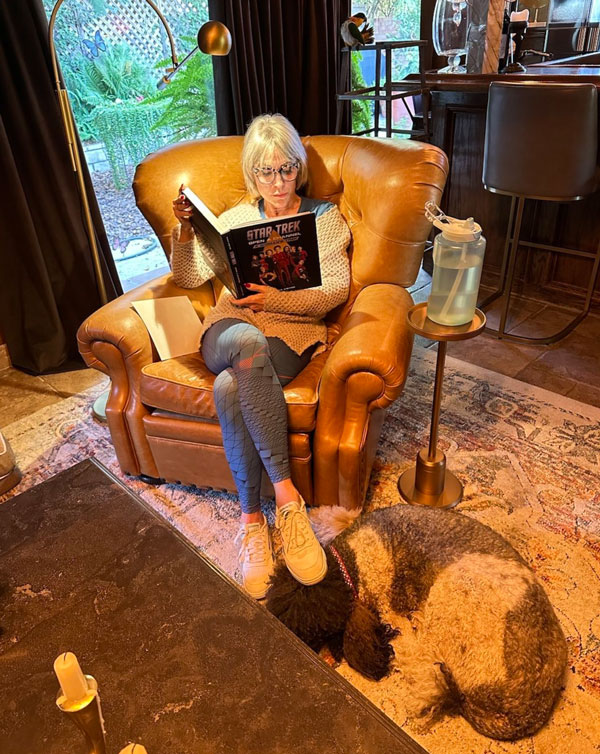
TREKCORE: You tell a lot of great anecdotes about your own experiences in this book — like when you were little and your mother would pull your hair putting your hair in rollers, saying “You have to suffer to be beautiful.”
That one really struck me because it reminded me so strongly of my own mother who would do the exact same thing. I had to have the rollers in and she would say, “It’s the cost of beauty.” Those were just the things that we grew up with; our moms were both perpetrators and victims of these things.
VISITOR: Because they’re passing down the way it works. And that made sense. You know, President Kennedy gave such a confusing speech for women saying, “Now we need you in the workforce, we welcome you in the workforce, once, basically, you do all your stuff at home.” What? And that was a big lesson of the time. It’s like the Enjoli woman, you know? “I can bring home the bacon, cook it up in a pan, and never let you—
TREKCORE and VISITOR: — “forget you’re a man.”
VISITOR: Yeah. [laughs]. So it’s all about him.
TREKCORE: Oh, yeah. I had that memorized too, as a young girl.
VISITOR: I used to strut around to that song, not even understanding I’m being programmed. And our mothers too, and that generation, I mean, they got it from all sides. As we do right now, in 10 years’ time, I’ll understand what culture is working on me at the moment. Right now, I’m sure I can’t see it.
But the media, the TV, that was so important at the time had these messages of how you’re supposed to look, how you’re supposed to behave, what will get you a man. The all-important thing. There was a lot to consider and a lot to juggle.
TREKCORE: One thing I was struck by how kind you were to everyone in the retelling of these stories. You seem to respect how complicated people are; there isn’t always a hero and a villain in a lot of these tales. How does that perspective inform what you think we should take from these kinds of stories?
VISITOR: Understanding that we don’t know where someone comes from and what they’ve been through, and what deals they’ve made with themselves to move forward, that’s important. So leading with compassion always seems to be a start at the basis of: “you are human”. They are human, so let’s go from there.
I have to say, I was so impressed with Brannon Braga because he did a really long interview with me — he had no idea how I was gonna write this book or how I was going to bring that narrative in, if I was looking for enemies to blame, and he was so forthcoming and so thoughtful. There is an activist who says, “Don’t call people out, call people in.” And I think that that’s one of the best things that I can do, is to explain how I got the way I was.
What you rob of a woman when you make her aware of sexuality when it’s not what we’re talking about at the moment. When it’s a workplace, how that hijacks her brain. I don’t think men know that.
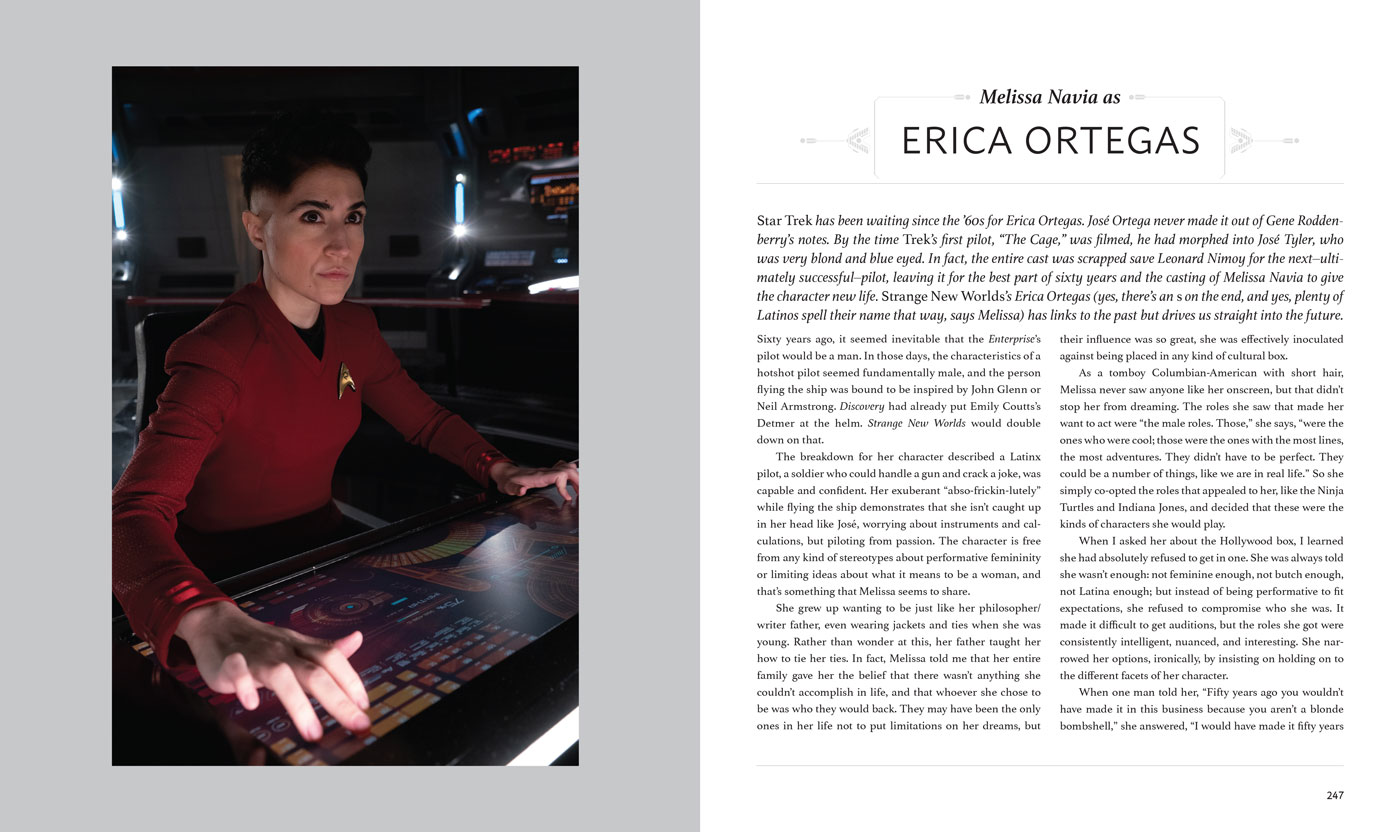
TREKCORE: Right. It’s just not their lived experience — they might not think in those terms, and that’s part of it. And talking about Braga in particular, there was one thing in the book that really took me aback.
Talking about how when Enterprise came on the air how the thought was, “Oh, we did the woman thing with Voyager. We’re done with that.” [laughs] Like, “We solved sexism, we’re done. Good job, everyone. Now we can do what we wanna do”..
VISITOR: Isn’t that a lesson? That made me realize you must not ever think the work is done. We slide so fast. We have to keep things at the forefront.
TREKCORE: How do you think we help them along — people in power in particular — go from just paying lip service to it to truly changing things?
VISITOR: Well, then I’ll go to Mike McMahan, who said, “If you love a system, keep questioning it. Don’t just go, ‘That’s just the way it is.'” Things will change when women are all through the hierarchy of power, not just at certain levels — and leaders, both men and women who give voice to the people that they’re working with. Cooperation.
I mean, patriarchy doesn’t seem to work so well, but neither does matriarchy. It’s not about that. It’s about leaders who understand that it’s a system. When something is true for the smallest thing, it’s true for the biggest thing, and our bodies rely on all the systems of our bodies being healthy and working together.
A well-oiled machine and that means everything is being cared for and listened to and worked with. So I think to me, that seems to be an answer. And it’s not about taking power away, it’s about hearing voices and hearing what needs to be done.
TREKCORE: Reading the sections about the women in the newer shows was like a healing balm after reading some of the experiences of the other generations of women — and if we could talk about the word “fuckable” for a little bit, which, you know, it’s a haunting word.
Reading that Melissa Navia hadn’t heard that word till she heard it on television, and that Jess Bush said no one would ever say that to her. This was so wonderful to hear.
VISITOR: I was thrilled to hear that.
TREKCORE: How did that feel talking to these women?
VISITOR: It felt thrilling. It was, of course, later in the whole process. And so when I asked this question — and I asked the question to most women because of my personal experience and they were like, “Oh, yeah, yeah. Oh, well.” And then finally, to get to these young women who were looking at me like I had three eyes, it was a sigh of relief.
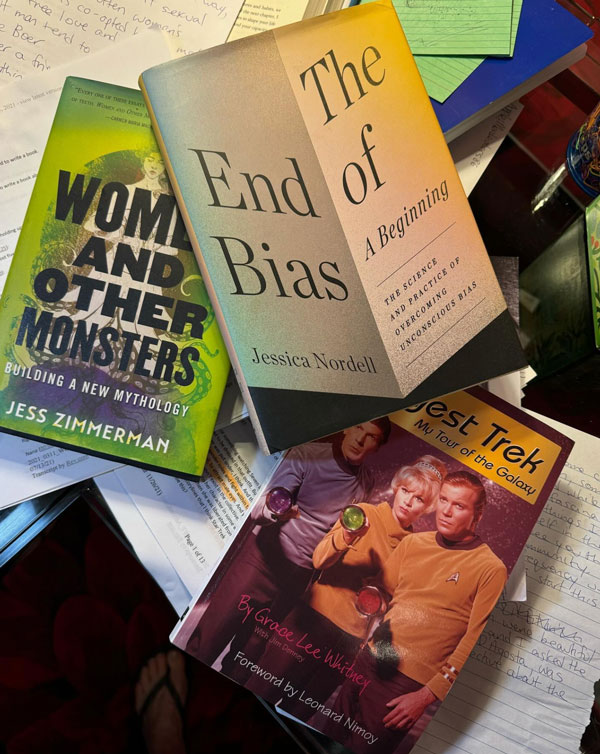
TREKCORE: I really enjoyed reading about was your early life and your early career before Star Trek — how you had to stereotype yourself and put yourself into these boxes. What did it feel like to focus, to reflect on that part of your life through this lens, your experiences as a girl, and a young woman?
VISITOR: I recommend it to everybody. To look back, and really think about it, and write about it, and think about yourself in terms of a larger system. It was upsetting, and I went through very hard times looking at myself hard. I mean, I had to do some reading to catch up on feminism, on what young women were thinking, on what the realities of bias were. And that was shocking.
If you wanna get shocked, read The End of Bias: A Beginning by Jessica Nordell. It opened my eyes and it made me aware of unconscious bias where I would go, “No, what? I don’t think that way at all.” And then you look deeper and there’s some cleaning up to do. I found that with myself, and it was hard to look so honestly at myself. It was upsetting, but certainly, it caused a big shift in me.
TREKCORE: Did you read these books specifically as research for this book?
VISITOR: Yes, but I didn’t know that I would be doing that. I didn’t sit there and go, “Okay, so I’m gonna research, I’m gonna do this.” I would do an interview, and my interviews were horrible to start with. [laughs] I wouldn’t stop talking. I was leading. I didn’t know how to do it. I learned that by watching them — and I learned when I would interview a woman and get stuck and go, “I don’t know what her experience is. I don’t understand this.”
Like with the guest stars, so like this behavior, they’re just shutting me down. They don’t want to answer. And then I did a look at the history of the time, and I went, “Ah, no, they’re not shutting me down.” This is the way they learned to be women. And this is the way the culture of the time taught them they needed to be. And then I’d talk to somebody else and go, “Oh my God, I don’t know enough about this.”
I’d stop and read and just educate myself with endless books, endless looking at history. There was, it was probably a week that I just went down a rabbit hole of 1960s and ’70s old commercials. I could have just done a section on that. It’s really shocking. And magazines. And then I went down a rabbit hole of popular music and what the messages were.
This is something, you know, we’re shopping and we’re listening to this music. The words are forming patterns in our heads without our awareness. If we’re aware, if we go, “Oh, wow that’s an interesting thing to be singing about,” it lifts us out of that rut. But if we’re not aware, that’s why we need to talk.
TREKCORE: “Open a Channel.”
VISITOR: Exactly.
TREKCORE: How did you come up with that title? When did you realize that was what this book was about?
VISITOR: I had this moment with astronaut Samantha Cristoforetti who is just a remarkable human. I was in Germany at ISA, and I had the opportunity to talk to her while she was on the space station — she really got a lot of encouragement from Star Trek to become an astronaut, an engineer, and everything else that she does. And while I was talking to her, I watched her bounce her way to the camera to talk to me. I was an actor on a set of a space station and this child watched that, got inspiration, now she’s in space and I’m talking to her and saying, “Hi, Samantha. It’s so good to see you again.” My brain did back flips. It was so huge and overwhelming.
And then I came home, and I went to lunch with Brian Fuller. And I was telling him about my experience, and I was telling him about my struggles with the book and I told him: “They said, “Open a channel.” That was my line. This was for real.” He said, “That’s the title of your book.”
Had the honor to interview astronaut Samantha Christoforetti today for A Woman’s Trek- what an extraordinary human @AstroSamantha pic.twitter.com/r9haJySCDa
— Nana Visitor (@NanaVisitor) February 12, 2022
TREKCORE: I want to ask you about the power of saying things out loud.
VISITOR: That’s huge.
TREKCORE: Yes — and this book is full of people retelling traumatic events, from little “t” trauma to the brave retelling your own personal trauma with a capital “T.” How do you view the importance of recounting these things that we usually try to avoid talking about directly?
VISITOR: I recently did a TEDx talk at Space Force. And I had young women and men come up to me and be in tears and say, “Thank you.” You know, France is going through this moment and it’s kind of wonderful. There’s this famous trial going on about rape and they are saying the shame is on the wrong person. It’s not ours, it’s theirs.
And to realize that we have shame about it, but it’s human. This is human experience. My mother would always say something, great: “If it happened, you can talk about it.” I’ve noticed is how it takes shame away from somebody else and keeping it in this dark place.
The moment you start talking about it, it absolutely sheds light — and once that shame is gone, we have all kinds of energy and mind possibilities to project in other ways, not in keeping us hidden.
TREKCORE: This book does a lot of that, for people who might not be aware that these things are so common, and the experience of so many people around them. I want men to read this book as much as women.
VISITOR: You know the men that have read it have responded in a really interesting, positive way. Dominic Keating read it and was like, “It makes me thoughtful about what we did on Enterprise. It makes me think about how I’ve been.”
In relationships, one-on-one, the therapist will teach you to say, not, “You did this. You did that,” but, “When this happened, I felt this,” because then you can be heard — instead of the other person shutting down and will freeze, won’t hear it because it’s too scary. But if they can understand your feelings, maybe they can hear you. It’s not an easy process. It’s not an easy process to do but that’s a direction that we can start to take.
TREKCORE: Open the channel?
VISITOR: Open the channel.
![]()
Our interview with Nana Visitor continues here.
Open a Channel: The Women of Star Trek is in stores now.
New STAR TREK: LOWER DECKS Images — “The Best Exotic Nanite Hotel”
The final season of Star Trek: Lower Decks continues this Thursday, and today we’ve got new images from “The Best Exotic Nanite Hotel” for your review!
This week, the Cerritos crew – including Mariner’s ex-girlfriend, Jennifer (Lauren Lapkus) the Andorian — heads to a Federation resort world to investigate a nanite infestation. Meanwhile, Boimler (Jack Quaid) goes undercover with Ransom (Jerry O’Connell) and Billups (Paul Scheer).
Here are four images from this week’s new episode:
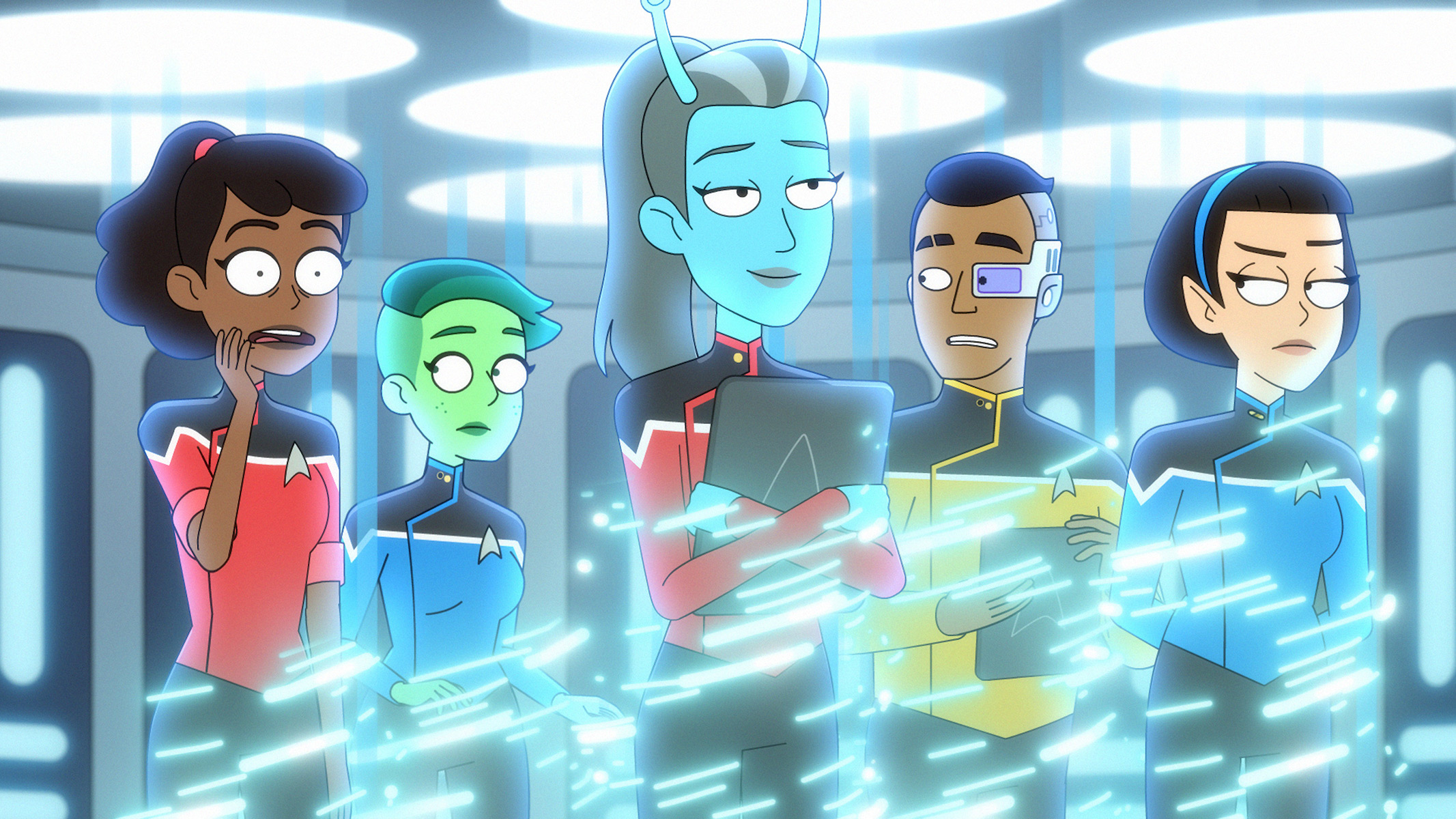
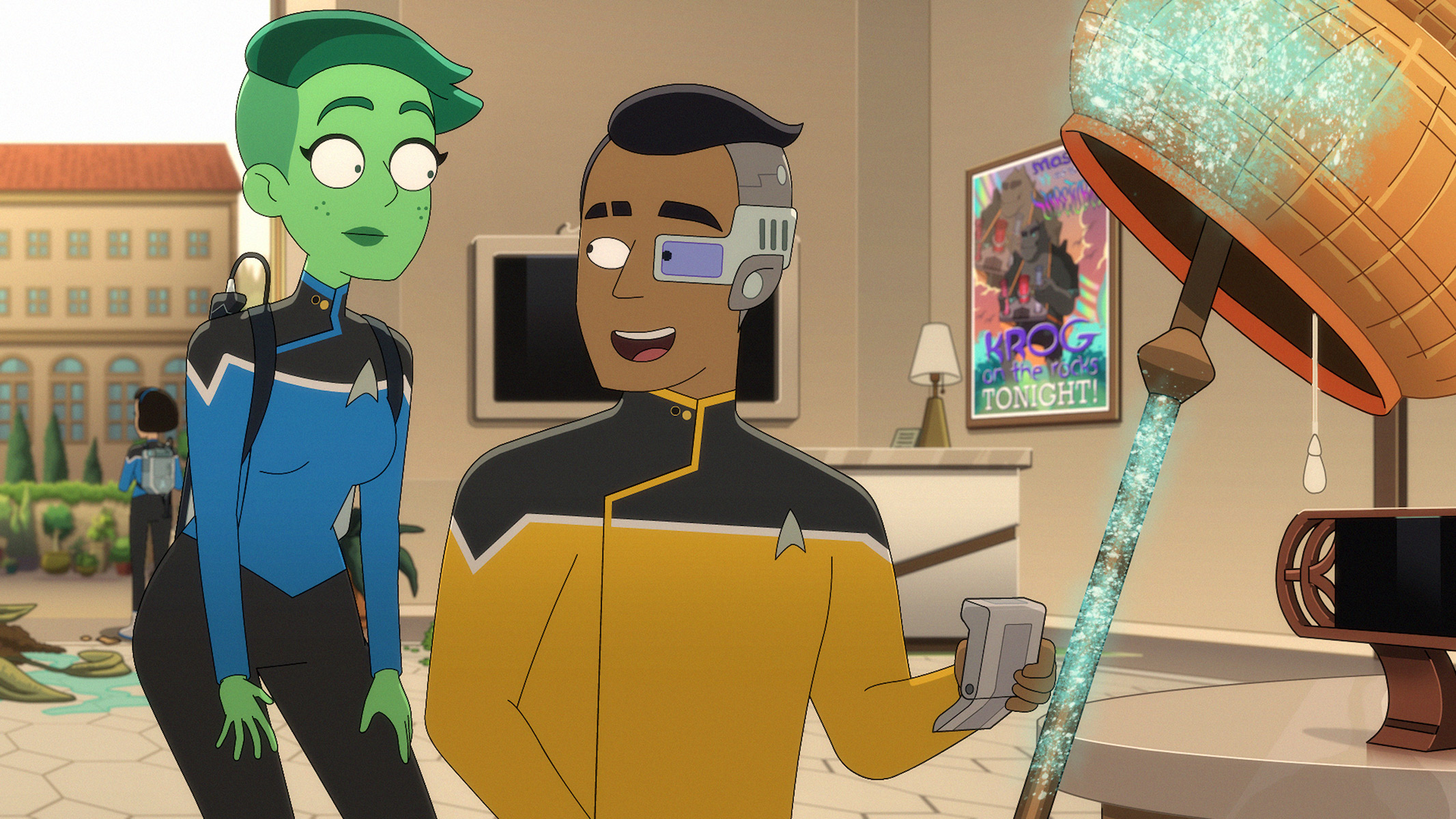
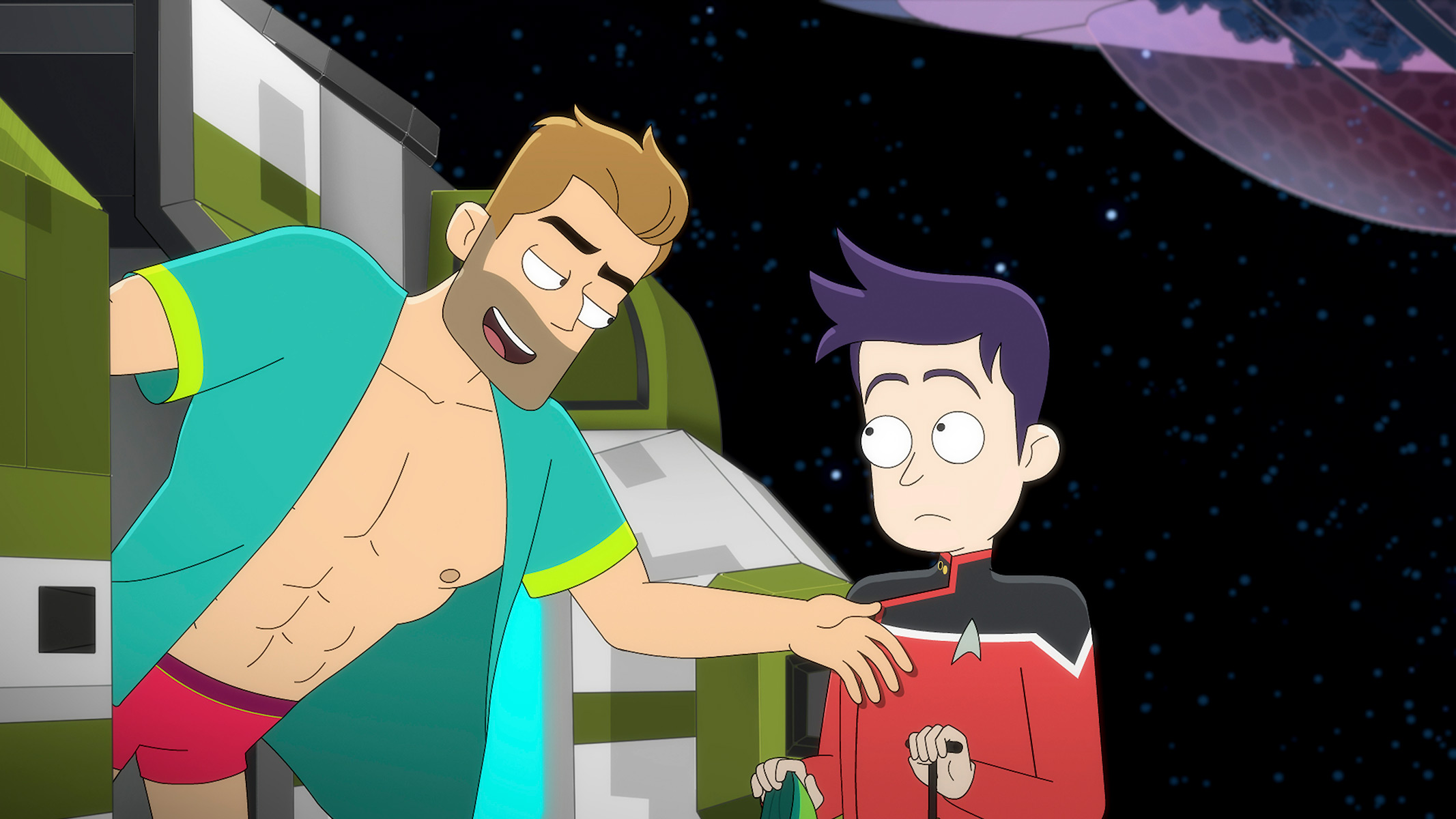
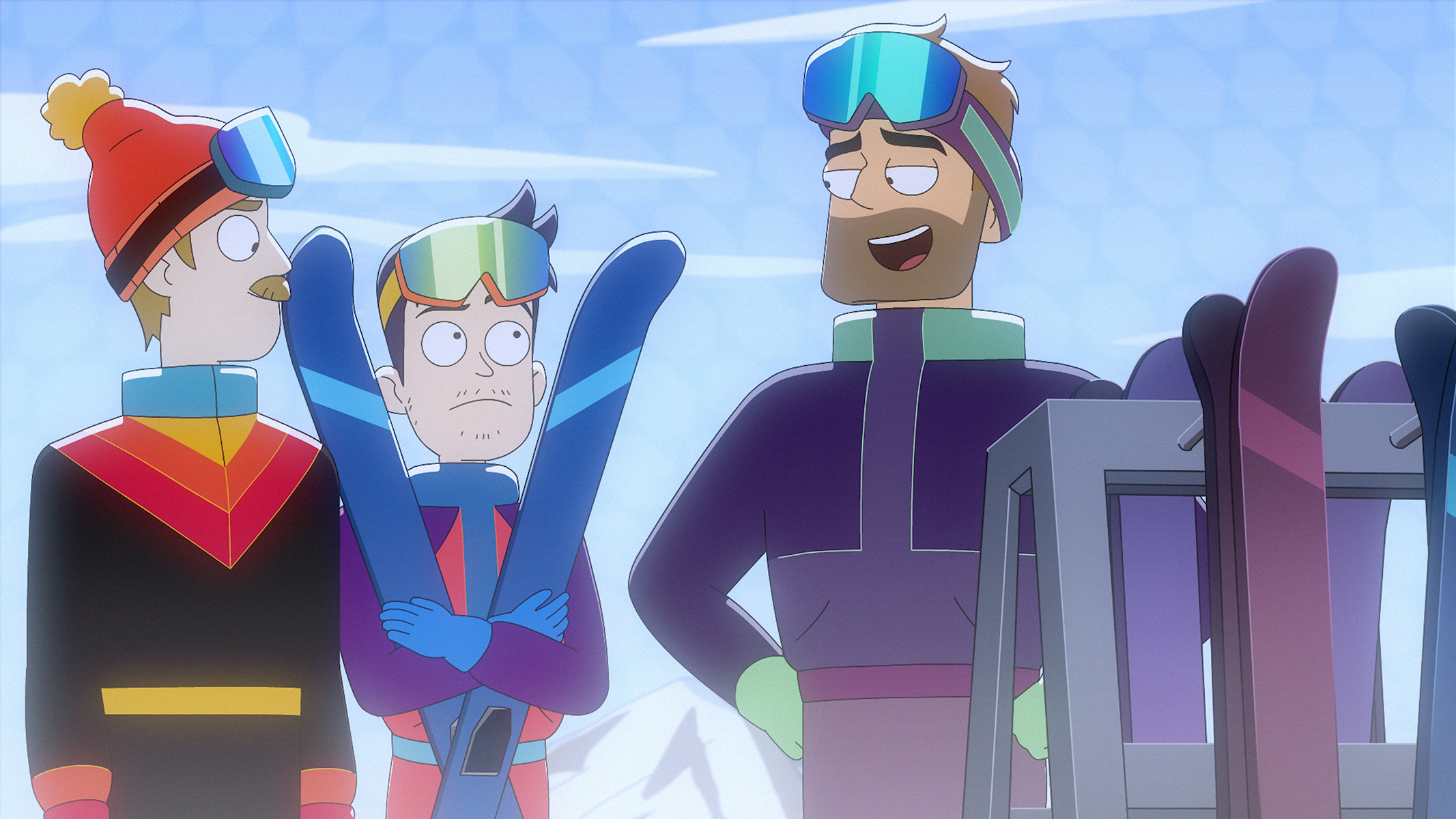
THE BEST EXOTIC NANITE HOTEL — The Lower Deckers hunt nanites on a resort in space.
![]()
Star Trek: Lower Decks Season 5 continues with “The Best Exotic Nanite Hotel,” premiering October 31 on Paramount+.
WeeklyTrek Podcast #262 — The STAR TREK UNIVERSE Hits New York Comic Con
On this week’s episode of WeeklyTrek — TrekCore’s news podcast — host Alex Perry is joined by Marina Kravchuk to discuss all the latest Star Trek news.
This week, Alex and his guest discuss the following stories from TrekCore and around the web:
- TrekCore: STAR TREK: STARFLEET ACADEMY Renewed for Season 2, Plus: Tatiana Maslany Joins Season 1 Guest Cast (03:52)
- TrekCore: Watch an Action-Filled Clip from the STAR TREK: STRANGE NEW WORLDS Season 3 Premiere, Plus: Rhys Darby to Guest Star (9:50)
- TrekCore: STAR TREK: SECTION 31 Movie Premieres January 24, Plus: See New Posters Revealing Each Character’s Name (17:41)
- TrekCore: STAR TREK: LOWER DECKS Debuts New Season 5 Clip and Homage Posters at NYCC (21:54)
- TrekCore: Nacelle Reveals First Eight STAR TREK Action Figures at NYCC… With Plenty of Character Surprises! (27:19)
In addition, stick around to hear Marina’s wish for another season of Star Trek: Prodigy, and Alex’s reminder to take your time to enjoy the last 10 episodes of the fabulous Star Trek: Lower Decks while they’re still new to us.
![]()
WeeklyTrek is available to subscribe and download each week on Apple Podcasts, Google Podcasts, and Spotify — and we’ll be sharing the details of each new episode right here on TrekCore each week if you’re simply just looking to listen in from the web.
Do you have a wish or theory you’d like to share on the show? Tweet to Alex at @WeeklyTrek, or email us with your thoughts about wishes, theories, or anything else about the latest in Star Trek news!

